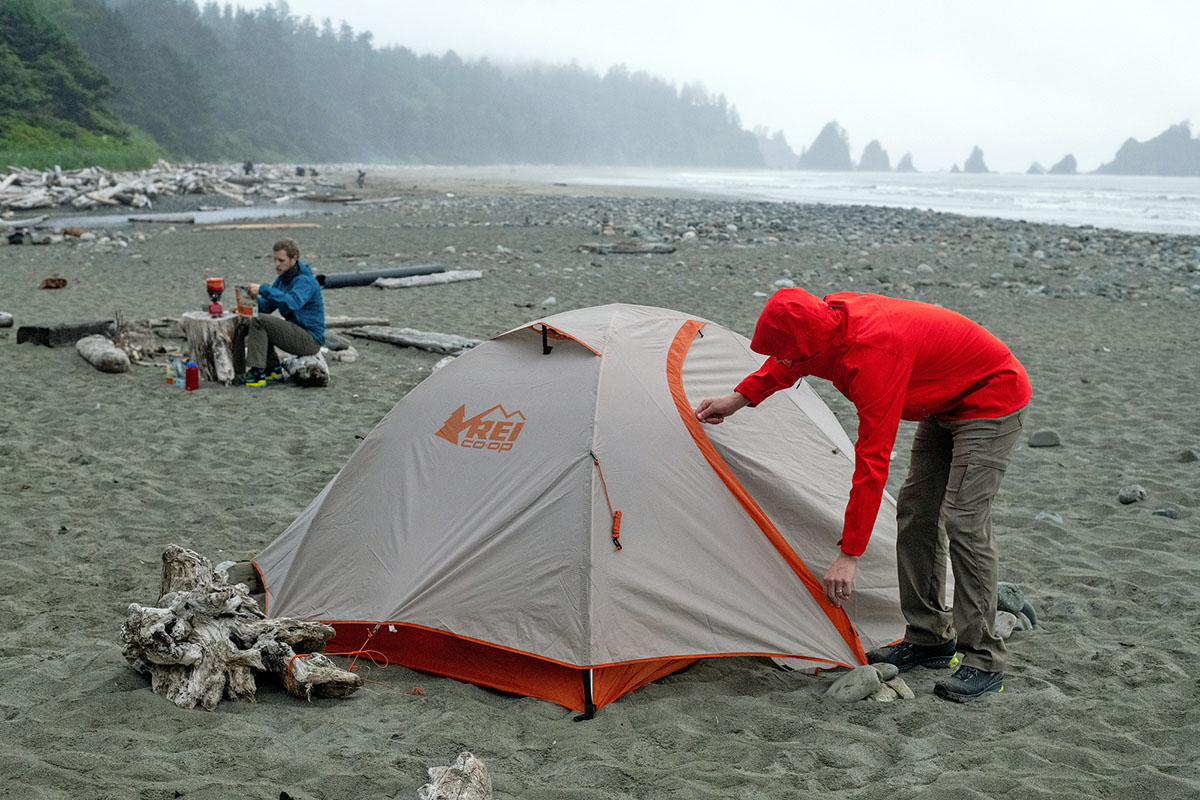
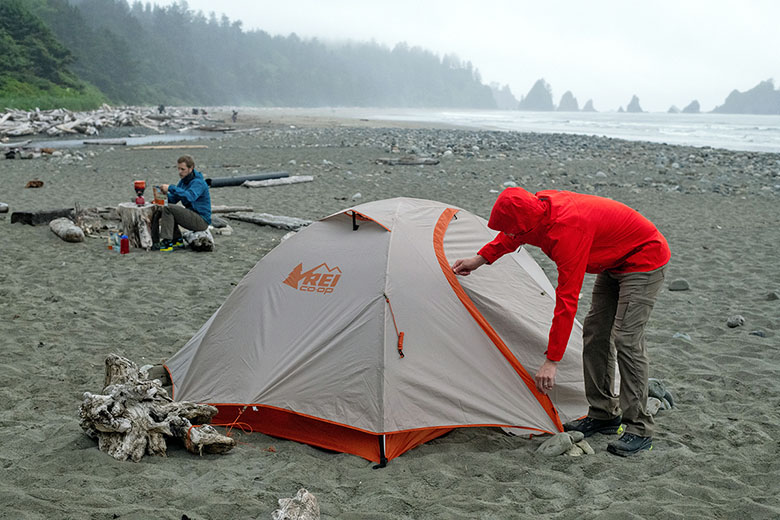
A premium two-person backpacking tent can cost upwards of $700, but not everyone needs best-in-class performance. Casual weekenders and those just dipping their toes into backpacking can save a lot of money with a budget design. These tents are often heavier and less engineered than top-shelf models, but they’re nevertheless well built and will keep you protected in a storm. REI Co-op dominates the value scene, but our list also includes tents from brands like Nemo, Coleman, Big Agnes, Kelty, and more. Below are the best budget backpacking tents of 2025. For additional information, see our comparison table and buying advice below the picks, along with details about our testing process.
Editor’s note: We updated this guide on April 17, 2025, to add the MSR Elixir 2 to our list. We also adjusted our product rankings, moving the Tarptent Double Rainbow down after a recent $50 price increase. Finally, we incorporated photos from recent testing and swept the guide to ensure all information was up to date at the time of publishing.
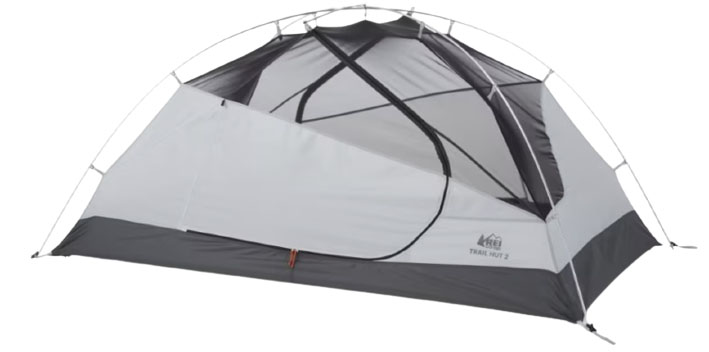 Packaged weight: 5 lb. 15.0 oz.
Packaged weight: 5 lb. 15.0 oz.
Floor dimensions: 88 x 52 in.
Capacity: 2P
What we like: All the tent most backpackers need for just $229.
What we don’t: You can spend up for more interior space and a lighter, more packable design.
REI Co-op’s in-house brand offers great bang for your buck, and their lineup of backpacking tents is especially impressive. In short, no other tent manufacturer provides a better combination of price and performance—the holy grail for budget seekers. The Trail Hut 2 is one step up from their entry-level offering (the Trailmade below) and far and away their most balanced budget design. The tent keeps costs low with a material set that emphasizes durability over weight-savings, but adds a nice boost in livability with a headroom-expanding ridge pole. What’s more, its weather protection is on par with (or surpasses) tents three times the price: We brought the Trail Hut 2 backpacking in Patagonia, and its strong poles and thick fly deftly handled rain and strong wind throughout many nights in the mountains.
We’ve spent a lot of time in a tent—and a lot of time in $600 tents—and keep coming back to the Trail Hut as one of the best values on the market. If you’re a casual backpacker or only get out a few times a year, you really don’t need anything more. Sure, it’s relatively heavy and bulky, and thus not our first choice for serious hikers who like to cover a lot of miles (to keep your pack weight low, check out the Durston X-Mid or Tarptent Double Rainbow below). And despite the addition of the ridge pole, the Trail Hut is still not as spacious as designs with pre-bent poles (like the Half Dome or Aurora). But for the price, you won’t find a more comfortable, stormworthy, and well-built tent, making the Trail Hut 2 our runaway favorite for 2025.
Read more: REI Co-op Trail Hut 2 review
See the REI Co-op Trail Hut 2
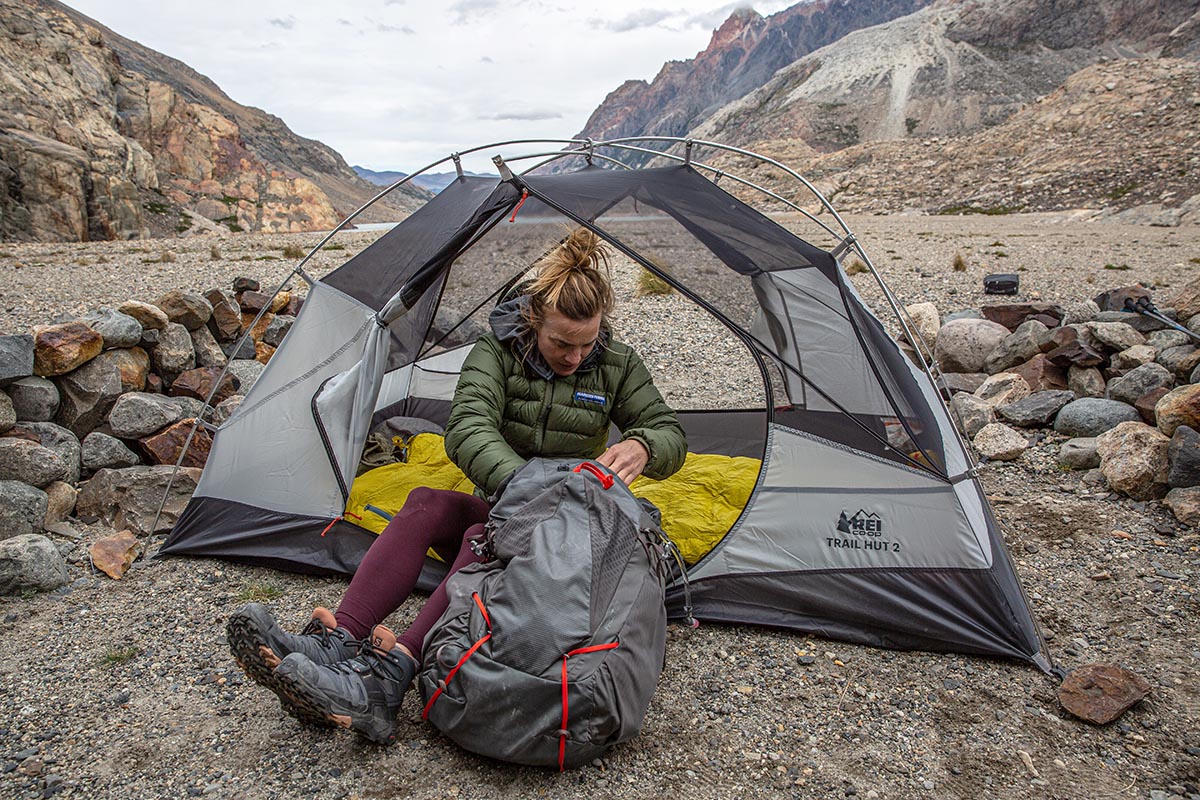
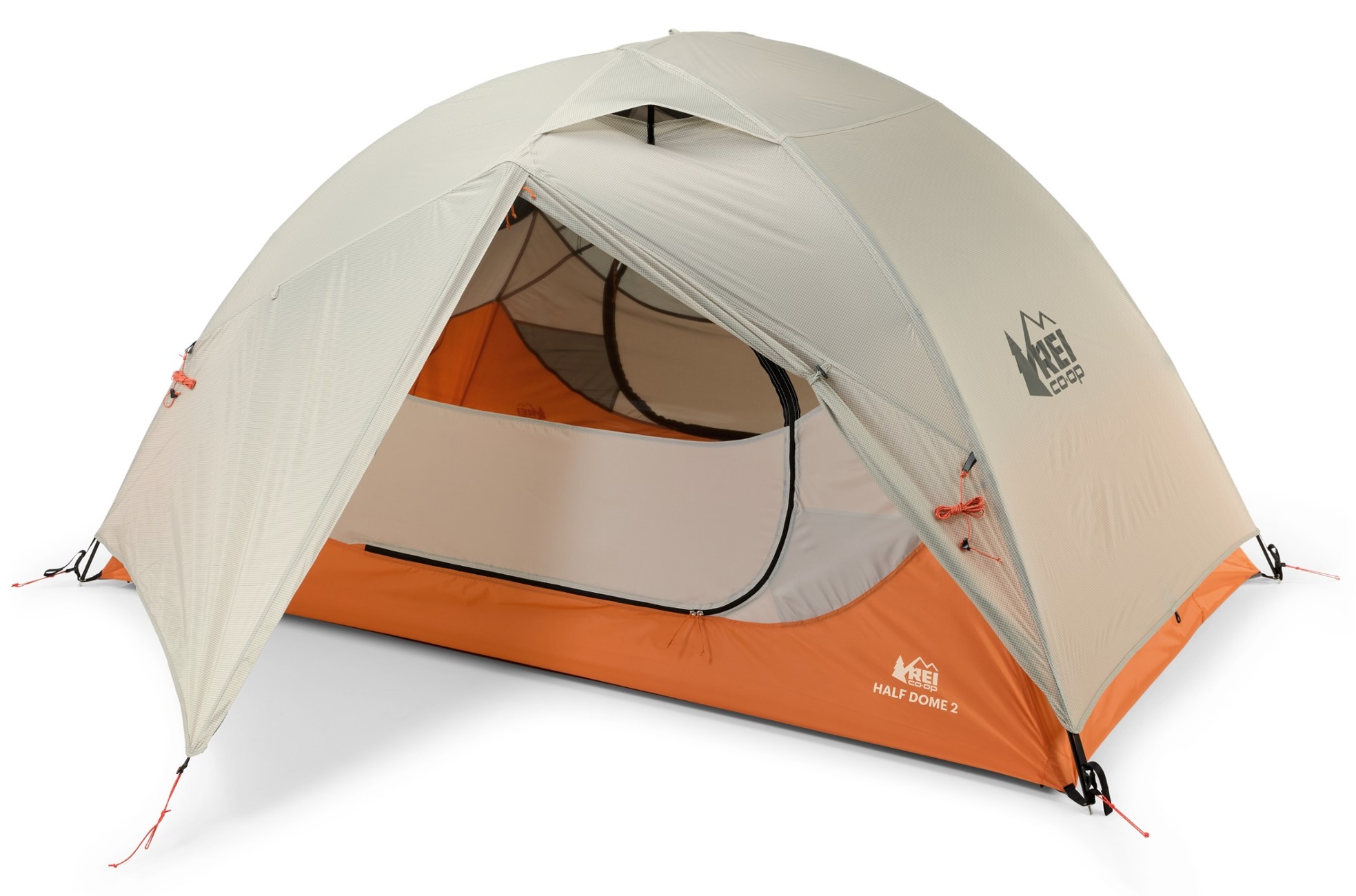 Packaged weight: 5 lb. 12.1 oz.
Packaged weight: 5 lb. 12.1 oz.
Floor dimensions: 88 x 52 in.
Capacities: 2P, 2+, 3P
What we like: A great combination of weight and livability for under $300.
What we don’t: Heavier and bulkier than high-end backpacking tents.
REI’s Trail Hut above is a function-first tent that will save you a lot of cash, but their mid-range Half Dome is the more well-rounded design. For $299, you get a sizable boost in livability thanks to steeper walls that provide more head and shoulder room. The Half Dome has been an icon for 45 years, and with the most recent update, it seems to have gotten even better. Changes for 2025 include more sustainable and robust materials, a revamped "HubCheck" system to help you know when the poles are seated correctly and secure, and ridge poles that extend farther over the entryways to provide more protection when getting in and out. If that wasn't enough, the rainfly now extends down farther for better weather protection.
The main reason the Half Dome dips into the budget category is weight: It simply can’t compete with top-tier tents like the Big Agnes Copper Spur ($550; 3 lb.). Bottom line, if you’re headed out for weeks at a time or plan to cover a lot of ground each day, it might be worth spending up. But you can drop over a pound by leaving the included footprint, bag, and other non-essentials behind, and the robust 75-denier (D) floor (upgraded from 40D) should stand up well to rocks and branches. If you’re looking to keep both weight and cost low, a tent like the Big Agnes C Bar below is worth a look, but you’ll give up a good deal of livability with a tapered floor plan and single-door design. All told, for the best of all worlds at a sub-$300 price point, the Half Dome is without rival—in fact, it’s the tent we recommend most to family and friends.
Read more: REI Co-op Half Dome 2 Plus review
See the REI Co-op Half Dome 2

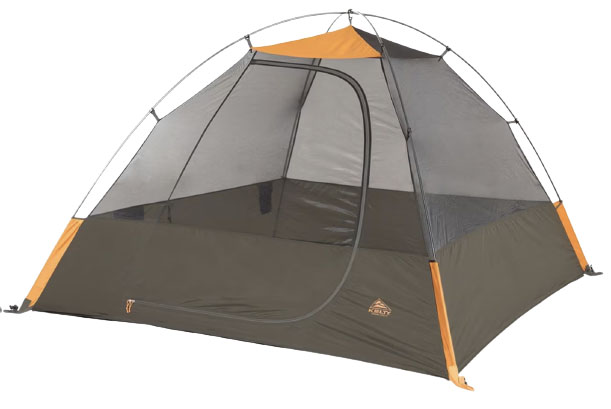 Packaged weight: 7 lb. 7.0 oz.
Packaged weight: 7 lb. 7.0 oz.
Floor dimensions: 98 x 80 in.
Capacities: 2P, 4P
What we like: Much lighter than two two-person tents.
What we don’t: Only one door; requires a large tent site.
Most of the tents here are designed to fit two sleepers—we do this both for comparison’s sake and because two-person designs are the most common and versatile size among backpackers. But if you’re traveling with children, want to mix in some car camping, or are willing to bear the extra weight burden for a roomier shelter, a four-person tent is a great solution. Within this category, the Kelty Grand Mesa 4 is a reasonably lightweight and affordable choice: For just $200, you get sufficient room for four side-by-side sleeping pads, a generous 56-inch peak height, and durable materials throughout. And unlike the 90’s-era REI tent that we spent countless nights in as a kid, the Grand Mesa 4 only weighs 7 pounds 7 ounces, which is just a few pounds heavier than most two-person designs here (and pretty manageable if you split up the carrying responsibilities).
If you're considering a four-person tent, keep in mind that it’s not your only solution for family backpacking trips. Opting for two two-person tents offers more room overall (including vestibule space) and can result in a better night’s sleep for everyone. What’s more, finding two small flat spots is often easier than one large tent site, depending on location. Finally, the Grand Mesa isn’t the most convenient option with just one door, and the mesh-heavy design isn't ideal for exposed areas or windy conditions. But for casual, below-treeline adventures and smaller parties, it’s a roomy choice and lighter than much of the competition. And specs aside, we wouldn’t trade anything for the memories of waiting out a high-country storm with the whole family, complete with a deck of cards and a good book.
See the Kelty Grand Mesa 4
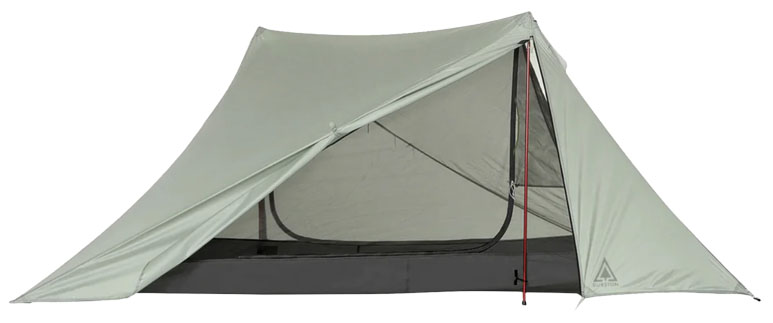 Packaged weight: 2 lb. 7.4 oz.
Packaged weight: 2 lb. 7.4 oz.
Floor dimensions: 92 x 52 in.
Capacities: 2P
What we like: Ultralight yet still relatively durable and spacious.
What we don’t: Trekking-pole shelters aren’t quite as user-friendly as standard tents.
In 2025, the ultralight backpacking movement has gone fully mainstream, with hikers of all kinds embracing the freedom that comes with a lightweight load. An ultralight tent is a key part of every UL kit: They check in about 3 to 5 pounds lighter than traditional alternatives and have a much more streamlined packed size. Some UL tents save weight with ultra-thin materials and tapered floor plans, while others go light by using trekking poles rather than tent poles for structure. The Durston X-Mid 2 is one such trekking-pole shelter, combining a minimalist 2-pound-7.4-ounce weight with relatively durable materials and a spacious floor area. In a category where many shelters cost as much as $700, it’s a true steal at just $280.
But trekking-pole shelters certainly aren’t for everyone, and especially new backpackers: They require an extra dose of attention to get a taut pitch, and the A-frame shape (rather than an arched-pole design) can compromise interior space. But after taking the Durston X-Mid 2 backpacking in Washington’s Cascade range, we were really impressed with its performance. The shelter was relatively easy to set up, withstood strong winds, and its unique offset pole design offered more livable space than many standard backpacking tents we’ve tested. What’s more, like the other tents here, its double walls allow condensation to easily escape the inner tent (most trekking-pole shelters are single-wall). All told, if you’re looking to lighten your load and willing to try something different, the Durston X-Mid is well worth a closer look.
Read more: Durston X-Mid 2 review
See the Durston X-Mid 2

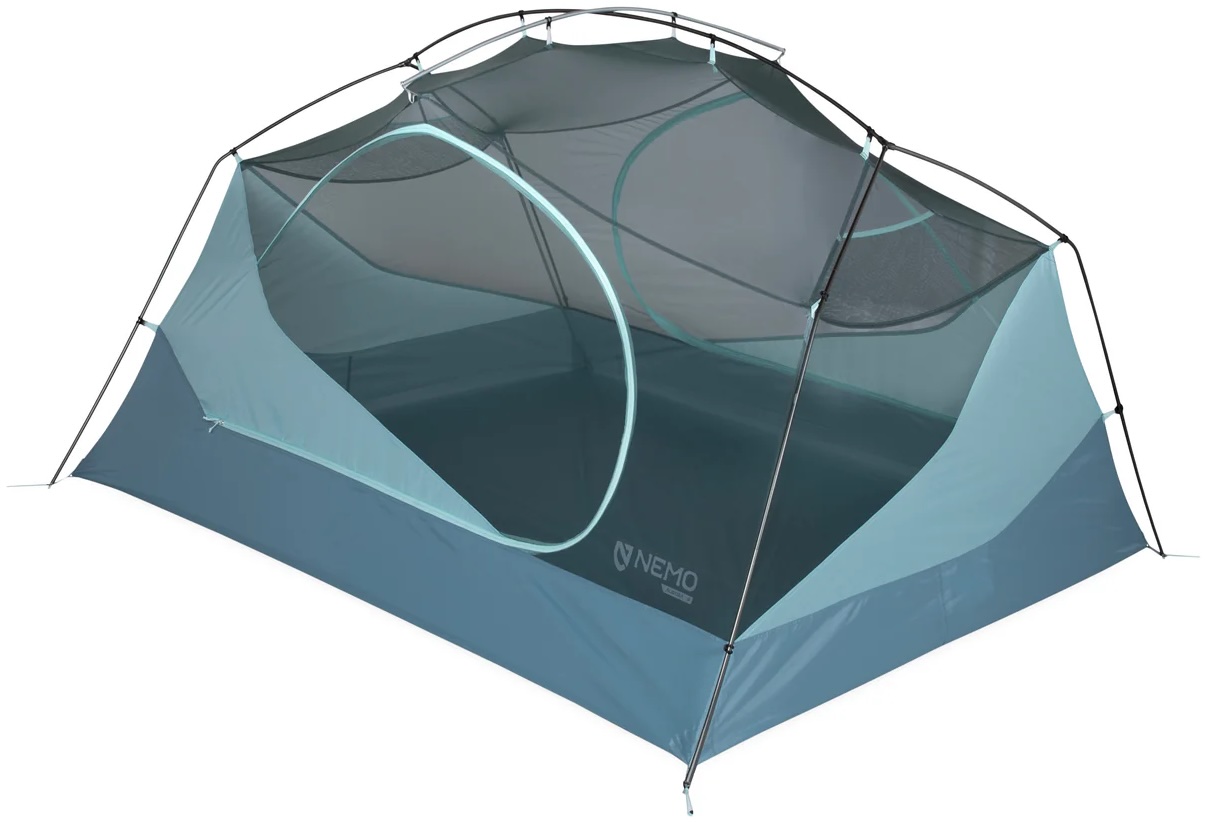 Packaged weight: 5 lb. 10.0 oz.
Packaged weight: 5 lb. 10.0 oz.
Floor dimensions: 88 x 53 in.
Capacities: 2P, 3P
What we like: Massive interior space and a premium feature set.
What we don’t: Not as weather-worthy as the Half Dome above.
Nemo makes some of the best backpacking tents in the business, so the release of their budget-oriented Aurora certainly caught our attention. A modern take on the simple entry-level tent, the Aurora offers a large amount of livable space by way of pre-bent poles (the interior feels quite open with four near-vertical walls), hubs at both the head and foot ends, and a ridge pole at the center. A symmetrical design and Nemo’s intuitive hardware make set up a breeze, and you even get thoughtful features like a light-diffusing pocket and a handy roll-top stuff sack. For casual or penny-pinching backpackers who want a step up in interior space and quality from most budget tents, the Aurora is certainly worth a look. Plus, the newest iteration of the tent features a more sustainable build that’s free of harmful PFAS, which are known as “forever chemicals” due to their inability to break down over time.
Priced at $300 (with an included footprint), the Aurora is on the spendy side of "budget", and we like the REI Half Dome 2 a bit better for the same price. We also found the REI gets the edge in wind protection—the very upright shape of the Nemo made it vulnerable to bowing in strong gusts on a trip in Colorado's San Juan Mountains. Weight-conscious hikers who get out a fair amount want to look for something on the lighter side, but the Aurora is still a durable and affordable choice, and it’s hard to beat the premium feel and finishes of a Nemo design. For more space, you can bump up to the Aurora 3P (88 x 73 in.) for $360.
Read more: Nemo Aurora 3P review
See the Nemo Aurora 2P
 Packaged weight: 5 lb. 7.0 oz.
Packaged weight: 5 lb. 7.0 oz.
Floor dimensions: 88 x 52 in.
Capacities: 1P, 2P
What we like: A reliable, durable, and affordable shelter from one of our favorite tent manufacturers.
What we don’t: Very cheap materials and saggy fly; the Trail Hut 2 above is significantly better for just $30 more.
REI Co-op’s Trail Hut 2 above is our favorite all-around budget tent, but you can save even more with the Trailmade 2 here. Part of REI’s Trailmade line—a functional and fun collection aimed to help more people get outside—the Trailmade 2 is easy to set up (there are simple instructions on the stuff sack), comes with all the necessary accessories (footprint, guidelines, stakes, etc.) and has a bargain basement price. What’s more, with no ridge pole, it’s also a half-pound lighter than the Trail Hut, and you can shave even more weight by leaving the 6.8-ounce footprint at home, too. Tack on durable materials and beefy poles that can handle high winds, and the Trailmade 2 is a reliable tent that will get the job done for just $199.
The Trailmade features an identical floor area and the same material weight as the Trail Hut (66D polyester), but it’s a far cry from our top pick in terms of build quality. On the model we tested, the rainfly didn’t properly fit the dimensions of the tent body—some sides were too long, others too short, and the seams never lined up perfectly. Combined with less guy-out points overall, and we were unable to get a taut pitch despite much tweaking. In addition, the Trailmade’s materials felt particularly cheap (most of all the coated polyester fly), the vestibule doors only offer a small opening to get in and out, and there’s very little interior storage (just one pocket beside each door). In the end, for just $30 more, the more spacious and premium-feeling Trail Hut is an easy choice for us. If you're building your kit from scratch, it's worth checking out REI's Trailmade 2 Backpacking Bundle, which features the tent, Trailmade 20 sleeping bag, and Trailmade sleeping pad for just $379.
Read more: REI Co-op Trailmade 2 review
See the REI Co-op Trailmade 2
 Packaged weight: 5 lb. 8.0 oz.
Packaged weight: 5 lb. 8.0 oz.
Floor dimensions: 90 x 52 in.
Capacities: 2P, 3P, 4P
What we like: A versatile budget design from one of the best tent makers in the business.
What we don’t: Pricier than the Trail Hut 2 and not as roomy as the Aurora.
Big Agnes makes some of our favorite lightweight backpacking tents, which feature high-quality construction and a great balance of performance and weight-savings. In the budget category, the Blacktail is their best all-arounder. Essentially Big Agnes’ version of the REI Trail Hut 2, the Blacktail 2 offers a roomy floor plan and generous headroom by way of pre-bent poles and a ridge pole at the apex. Ventilation is high with a good amount of mesh in the body and two rainfly vents, and two doors and two vestibules make living easy for two. Finally, the Blacktail includes the same premium finishes we see in Big Agnes’ pricier designs, including details like a Quick Stash doorkeeper, media pockets with cord routing, and precut guylines.
At $250, the Blacktail 2 will cost you around $20 more than the Trail Hut 2, and unlike the REI design, it’s less likely to be found on sale. On the other hand, the Blacktail is a full pound lighter yet still features durable 75D fabrics for the floor and fly. But the Big Agnes does fall a bit in between categories: If we really want to save money, we’ll reach for a tent like the Trail Hut 2 above; if headroom is top priority, the Nemo Aurora is a better pick. But for a well-rounded tent that puts it all together, the Blacktail 2 is a great design with Big Agnes’ tried-and-true quality.
See the Big Agnes Blacktail 2
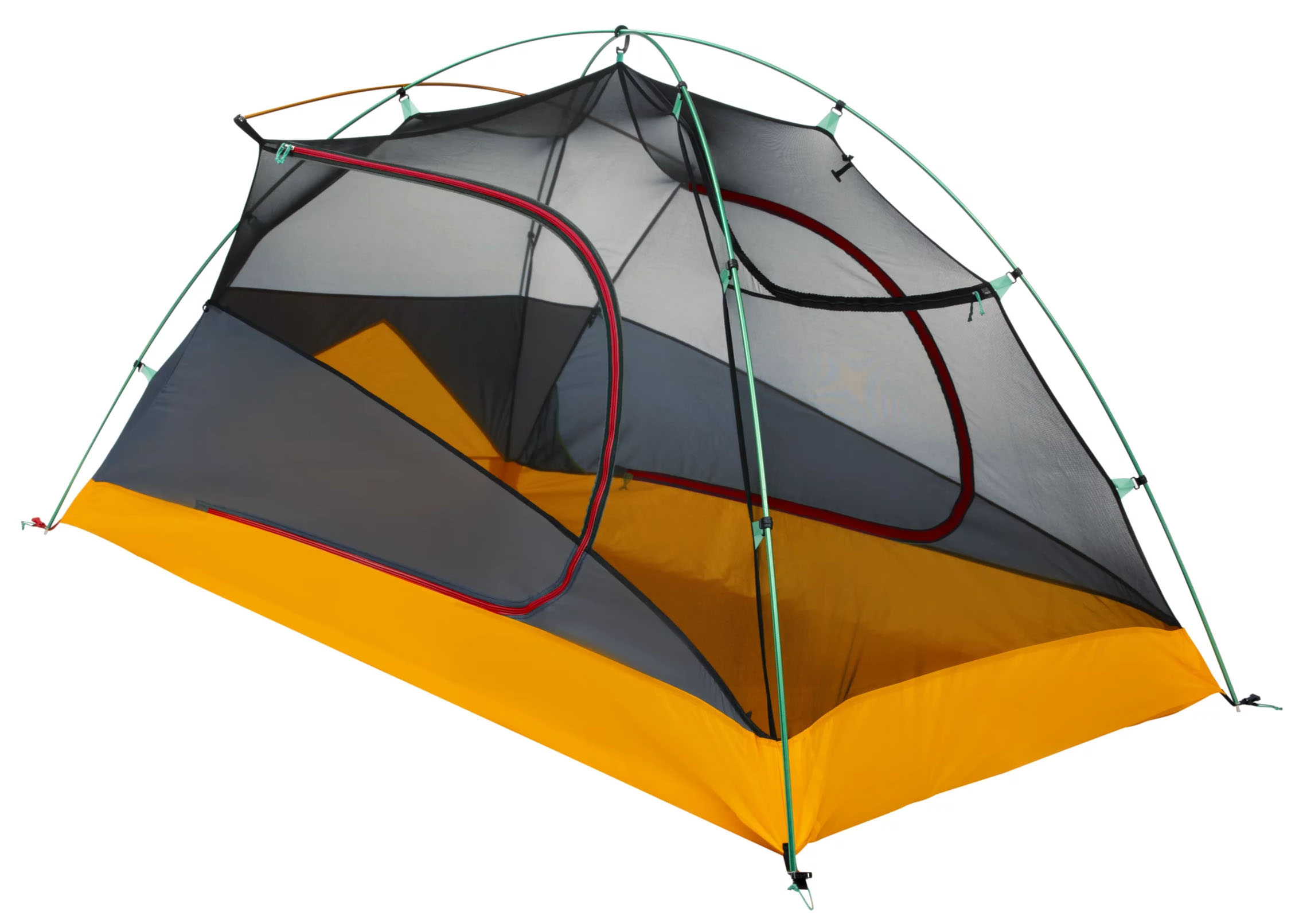 Packaged weight: 6 lb. 1.0 oz.
Packaged weight: 6 lb. 1.0 oz.
Floor dimensions: 88 x 52 in.
Capacities: 2P, 3P, 4P, 6P
What we like: Uncharacteristically modern for a Coleman; solid livability and protection for the price.
What we don’t: A bit heavier and more expensive than the Trail Hut 2.
Coleman's name is synonymous with budget camping, but they're making a push into the modern era with collections like their backpacking-ready Peak1. While expensive by Coleman standards, the $320 Peak1 (note: It's listed at $270 through many other retailers at the time of publishing) is still a steal in the wider backpacking tent market and stands out in a couple key areas. First is weather protection: The tent is rated to withstand heavy winds (up to 45 mph according to Coleman) thanks to its robust aluminum pole structure and features a full-coverage rainfly and taped seams to seal out moisture. Coleman also included nice touches like reflective detailing for visibility at night, a unique "star view" window that unzips from the inside for stargazing, and a footprint to maximize longevity. It's all wrapped up in an uncharacteristically modern package that competes closely with leading designs like REI's Trail Hut.
At 6 pounds 1 ounce for the two-person version, the Peak1 wouldn’t be our first choice for long and arduous backcountry trips, but it will certainly get the job done for most casual backpackers. Compared to the aforementioned Trail Hut, the Coleman is a couple ounces heavier and about $90 more expensive but gets the slight edge in durability with marginally thicker poles and components (the difference is very minor). In terms of livability, both tents feature 88- by 52-inch footprints, although the Peak1 is 2 inches taller at its peak. The REI has a longer track record of success, but we're excited to see Coleman stepping up their game.
See the Coleman Peak1 2P
 Packaged weight: 4 lb. 2.0 oz.
Packaged weight: 4 lb. 2.0 oz.
Floor dimensions: 86 x 52/42 in.
Capacities: 2P, 3P
What we like: Lightweight for a budget tent.
What we don’t: Cramped living quarters for two and not very wind-resistant.
When you opt for a budget tent, there’s no escaping without a little compromise in terms of interior space or weight. But it’s a spectrum: Some tents tack on a few extra ounces for the sake of livability, while others streamline the build in order to keep weight low. Big Agnes’ C Bar 2 falls into the latter category, with a minimalist design reminiscent of their ultralight Fly Creek. You get just one door and vestibule, a mesh-heavy canopy, and a tapered roof and floor area that keep materials to a minimum. It’s a tight squeeze for two—you won’t be able to sit up at the same time as your tent mate and will practically have to crawl over them to get in and out—but at just over 4 pounds, the C Bar 2 is the lightest freestanding design to make this list.
For solo hikers or those trying to shave weight from their pack, the C Bar 2 is a really nice budget offering. But the interior space is a far cry from models like the Nemo Aurora and Half Dome above, and you’ll have to ask yourself if it’s worth the sacrifice to save a pound and a half. Further, the simplified pole structure (just one pole down the spine) and mesh-heavy design will suffer in heavy winds. If you’re truly serious about streamlining your load, it’s worth considering a more premium tent like the Big Agnes Fly Creek UL2 ($400) or Tiger Wall UL2 ($480) or opting for a trekking pole-supported shelter like the 2-pound-7.4-ounce Durston X-Mid above. But Big Agnes is one of the top manufacturers in the game, and you’d be hard-pressed to find a lighter freestanding tent at the $250 price point.
See the Big Agnes C Bar 2
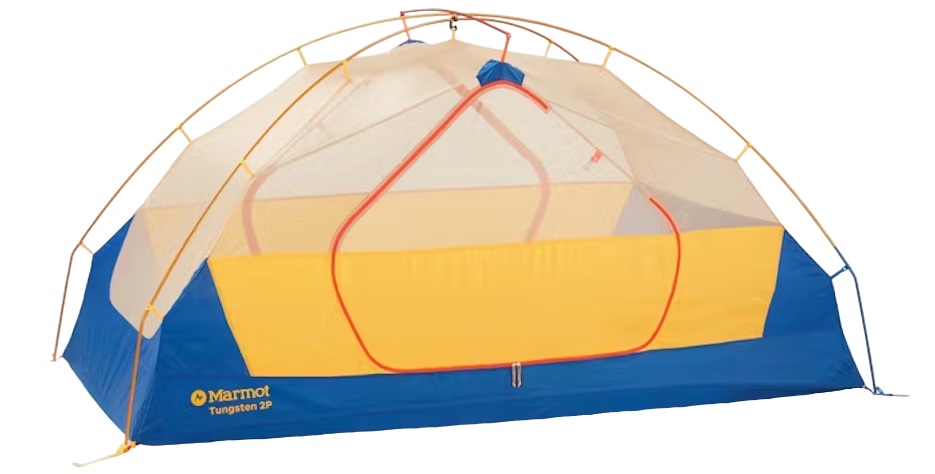 Packaged weight: 4 lb. 15.7 oz.
Packaged weight: 4 lb. 15.7 oz.
Floor dimensions: 88 x 54/46 in.
Capacities: 1P, 2P, 3P, 4P
What we like: Mix of solid nylon and mesh provides good ventilation alongside privacy and weather protection.
What we don’t: Headroom is compromised with the tapered shape.
We’ve mentioned REI as a great one-stop-shop for value, but Marmot isn’t far behind. For a decently low price of $249, their Tungsten is a durable 3-season tent with all the features that most weekend backpackers need. Like the C Bar above, the Marmot features a tapered floor plan (8 in. narrower at the feet), which saves you weight while still offering ample room for two side-by-side sleepers. On the tent body, the mix of solid nylon and mesh provides good ventilation alongside privacy and weather protection, and the updated colorways add a nice amount of flair.
All that said, the Tungsten's tapered design isn’t for everyone: You’ll have to sleep shoulder-to-shoulder with your tent mate (some prefer a head-to-toe arrangement for more space), and there’s not a lot of room to sit up side by side. For $50 more, we prefer REI's roomier and symmetrical Half Dome 2 above, although the Marmot makes for a nice hybrid backpacking and car camping option due to its lower weight. It’s also worth noting that Marmot makes another well-priced tent in their Limelight 2P ($299), which also offers more room at the cost of some added weight.
Read more: Marmot Tungsten 4P review
See the Marmot Tungsten 2P
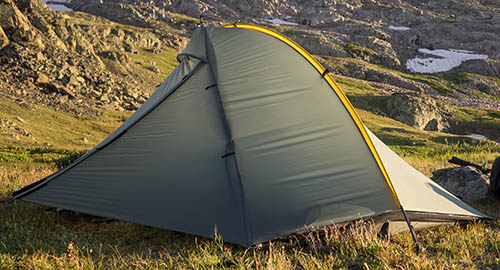
Packaged weight: 2 lb. 9.8 oz.
Floor dimensions: 88 x 50 in.
Capacities: 1P, 2P, 3P
What we like: A solid value for a sturdy and relatively approachable ultralight tent.
What we don’t: Price went up by $50 recently; not freestanding and seam-sealing costs extra.
California-based Tarptent isn’t a household name like REI or Nemo, but the cottage brand offers an inspiring ultralight lineup at reasonable price points. The Double Rainbow is our favorite model, featuring a unique hybrid single-wall design that keeps weight in check while maintaining impressive livability. For just over 2 and a half pounds, you get a reasonably thick 30D floor (15D is standard among UL tents), an aluminum arch pole to maximize headroom, a generous and symmetrical floor plan that easily fits two sleepers, and two doors and vestibules for convenient entry/exit and gear storage. Plus, the Tarptent’s hybrid single-wall construction means setup is a breeze: Simply thread the main pole through the sleeve in the rainfly and stake everything out (the “tent body” is made of mesh and hangs from the bottom of the fly). This is particularly nice in wet conditions, as there’s no moment during the setup process when the inside of the tent is exposed to rain.
We used to rank the Double Rainbow higher on our list, but a recent price jump of $50 caused us to reconsider. To be fair, $350 is still a reasonable price for an ultralight tent ($379 if you go with carbon fiber poles), but the Durston X-Mid 2 above is a bit roomier, slightly lighter, and cheaper by around $70. On the flip side, the Tarptent is a cinch to set up and doesn’t require the same learning curve as a trekking pole-supported design like the Durston, although trekking poles are required to make it fully freestanding (otherwise, you’ll need soft ground or good anchors to get a taut pitch). Lastly, it’s worth noting that the Double Rainbow doesn't come seam-sealed, but it’s a fairly simple DIY process, or you can add it onto your order for $35, bringing the total up to $384.
Read more: Tarptent Double Rainbow review
See the Tarptent Double Rainbow
 Packaged weight: 4 lb. 12.0 oz.
Packaged weight: 4 lb. 12.0 oz.
Floor dimensions: 85 x 54/45 in.
Capacities: 1P, 2P, 4P
What we like: Inexpensive, durable, and reasonably lightweight.
What we don’t: No rainfly vents and all-mesh body suffers in high winds.
For the true budget seekers among us, Kelty’s Late Start is another decent backpacking tent at a very low price point. This tent is about as simple as they come, with an all-mesh body and bathtub floor, simple crisscrossing pole structure, and one door and vestibule. Set-up is a breeze with pole sleeves at each corner (this is a bit archaic, but it still gets the job done), and despite the robust 68D fly and floor, the Late Start is reasonably lightweight (for a budget tent, that is) at 4 pounds 12 ounces all in. For summer backpackers who want to keep their pack weight in check, it’s a roomy alternative to the cramped C Bar 2 above.
That said, the Late Start slots in toward the bottom of our rankings for a few reasons. First off, unlike designs like the Trail Hut and Aurora above, the Kelty is not sold with a footprint. In most cases, we’d have no qualms pitching this tent directly on the ground (the 68D floor is thick enough to withstand contact with sharp rocks and branches), but it’s still a noteworthy omission. Further, the Late Start features a tapered floor, limiting interior space and forcing you to sleep shoulder-to-shoulder with your partner. And finally, the all-mesh canopy is not ideal in high winds. But for a low-cost backpacking tent that's fairly light and durable, the Late Start earns a spot on our list. And if you’re in search of even more savings, it’s also worth checking out Kelty’s two-person Ashcroft ($125) and Tanglewood ($90) tents.
See the Kelty Late Start 2
 Packaged weight: 6 lb. 3.0 oz.
Packaged weight: 6 lb. 3.0 oz.
Floor dimensions: 84 x 52 in.
Capacities: 1P, 2P, 3P, 4P
What we like: A budget-friendly tent with a premium feel.
What we don’t: One of the smallest, heaviest, and most expensive tents on our list.
Much like REI’s Trailmade series, the Elixir is MSR’s entry-level tent. It's easy to set up and comes with all the bells and whistles you’ll need for a comfortable night’s sleep in the backcountry, including a rainfly, footprint, and color-coded poles. We tested this tent on a multi-day backpacking trip in Wyoming's Wind River Range and came away impressed by how well it held up to downpours and high winds. With two side doors, it’s easy to share with a partner, and we had no issues splitting our gear between the interior mesh pockets and large dual vestibules. And unlike many budget tents, the Elixir has a high-quality feel throughout—reminiscent of MSR's pricier tents—and we don’t doubt it will last us several seasons to come.
That said, the MSR Elixir 2 doesn't strike us as a particularly solid value at $320, which is a considerable $91 more than the top-ranked REI Trail Hut 2 and $121 more than the Trailmade 2 above. It certainly has a higher-end feel than both of those tents, but it's shorter lengthwise by 4 inches and the heaviest of the bunch at 6 pounds 3 ounces all in. In fact, this makes it the heaviest two-person tent to make our list this season. It's also on the smaller end in terms of interior space, although we didn't find this to be too big of an issue in practice (and it is 1 in. taller at its peak than both REI tents). At the end of the day, we think most campers will be better off saving with the Trail Hut or Trailmade, but the Elixir's premium build at a reasonable price earns it a spot on our list this season.
See the MSR Elixir 2
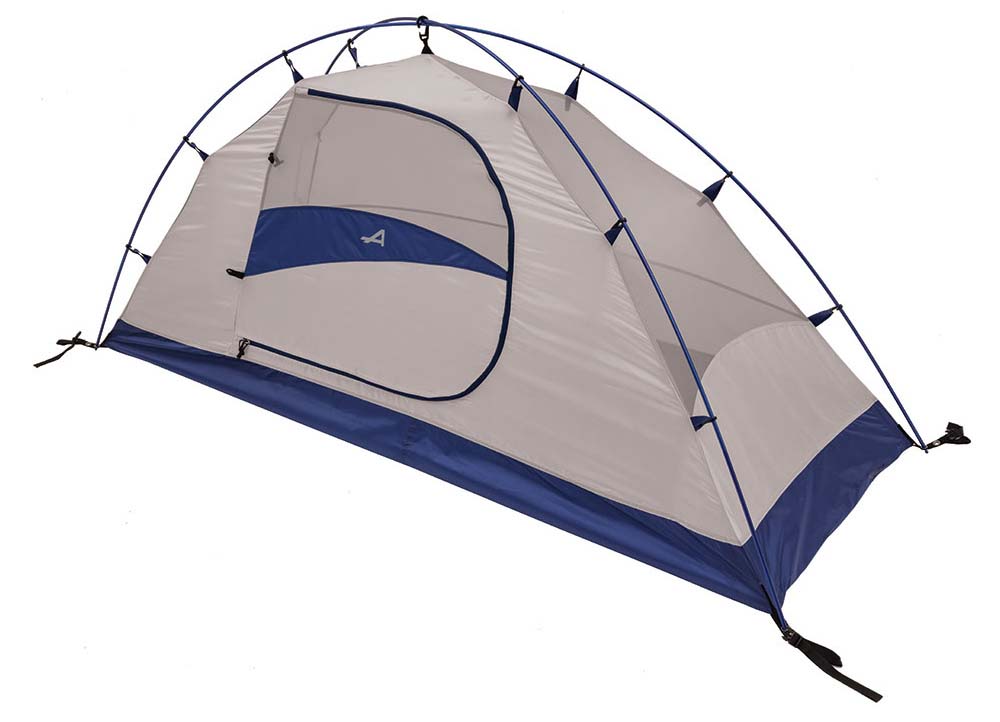 Packaged weight: 4 lb. 1.0 oz.
Packaged weight: 4 lb. 1.0 oz.
Floor dimensions: 87 x 29 in.
Capacities: 1P, 2P, 3P, 4P
What we like: Bargain-basement price and good feature set for solo backpackers.
What we don’t: Budget build quality.
Alps Mountaineering is not at the forefront of innovation, but they certainly win out in terms of price. For just $120—and commonly found on Amazon for less than $100—the Lynx 1 is a great value for solo backpackers. It’s roomy for one, offers good weather protection and ventilation including two vents up top, and has a large door and vestibule for storing your gear at night. The Lynx is also pretty tough with a burly 75D floor and substantial zippers, which is great for those who are hard on their gear.
For folks who consistently travel alone in the backcountry, a one-person tent is a really good option to consider. You obviously lose the versatility of a 2P model, but otherwise there aren’t a whole lot of downsides to the streamlined floor plan, and you even get enough room for a canine companion. Within the one-person tent market, it's also worth checking out the REI Co-op Trailmade 1 ($179) and Kelty Late Start 1 ($140), but the Lynx wins out in price and weather protection (thanks to more solid fabric in the tent body) and is a half-pound lighter than the Trailmade to boot. It’s for good reason that Alps has carved out a following among beginner backpackers and those on a tight budget. Just be sure to set reasonable expectations in terms of materials and build quality.
See the Alps Mountaineering Lynx 1
| Tent | Price | Weight | Floor Dimensions | Floor Denier | Capacities | Footprint |
|---|---|---|---|---|---|---|
| REI Co-op Trail Hut 2 | $229 | 5 lb. 15.0 oz. | 88 x 52 in. | 66D | 2P | Yes |
| REI Co-op Half Dome 2 | $299 | 5 lb. 12.1 oz. | 88 x 52 in. | 75D | 2P, 2+P, 3P | Yes |
| Kelty Grand Mesa 4 | $200 | 7 lb. 7.0 oz. | 98 x 80 in. | 68D | 2P, 4P | No |
| Durston X-Mid 2 | $280 | 2 lb. 7.4 oz. | 92 x 52 in. | 20D | 1P, 2P | No |
| Nemo Aurora 2P | $300 | 5 lb. 10.0 oz. | 88 x 53 in. | 75D | 2P, 3P | Yes |
| REI Co-op Trailmade 2 | $199 | 5 lb. 7.0 oz. | 88 x 52 in. | 66D | 1P, 2P | Yes |
| Big Agnes Blacktail 2 | $250 | 5 lb. 8.0 oz. | 90 x 52 in. | 75D | 2P, 3P, 4P | No |
| Coleman Peak1 2P | $320 | 6 lb. 1.0 oz. | 88 x 52 in. | 68D | 2P, 3P, 4P, 6P | Yes |
| Big Agnes C Bar 2 | $250 | 4 lb. 2.0 oz. | 86 x 52/42 in. | 75D | 2P, 3P | No |
| Marmot Tungsten 2P | $249 | 4 lb. 15.7 oz. | 88 x 54/46 in. | 65D | 1P, 2P, 3P, 4P | Yes |
| Tarptent Double Rainbow | $349 | 2 lb. 9.8 oz. | 88 x 50 in. | 30D | 2P, 3P | No |
| Kelty Late Start 2 | $160 | 4 lb. 12.0 oz. | 85 x 54/45 in. | 68D | 1P, 2P, 4P | No |
| MSR Elixir 2 | $320 | 6 lb. 3.0 oz. | 84 x 52 in. | 75D | 1P, 2P, 3P, 4P | Yes |
| Alps Mountaineering Lynx 1 | $120 | 4 lb. 1.0 oz. | 87 x 29 in. | 75D | 1P, 2P, 3P, 4P | No |
As longtime gear testers and reviewers, the Switchback Travel staff has watched tents soar in price over the years, so we’re intimately familiar with the plight that new backpackers face. Former senior editor Jenny Abegg compiled our initial list of 10 wallet-friendly picks in 2022. An avid mountain runner and rock climber, Jenny has spent countless nights outside and is always on the hunt for a good value. Former contributing editor Nick Mott took over the guide in 2024. Nick’s time spent hauling heavy loads deep into wilderness areas all over the West has given him a keen eye for the weight, durability, and performance required of a quality backpacking tent. Editor Maddie Downie currently manages the guide. Based in Washington state, Maddie has backpacked extensively throughout the western U.S. and British Columbia and knows firsthand how important a high-quality and reliable tent is for enjoying time outside.
Our collective experience in the backcountry—along with feedback from contributors and the online backpacking community—helped us whittle down our list to the 14 picks you see above. When we put backpacking tents to the test, our primary considerations are weight and livability (our favorites strike a nice balance between the two). At the same time, we also take into account weather-worthiness, ease of setup, and storage (both internal and external). Of course, price is a big factor for many, and it’s a critical ranking criteria for our budget picks above. Since the market is constantly evolving, we continue to put new and noteworthy designs to the test, making changes to the list above based on our experiences.
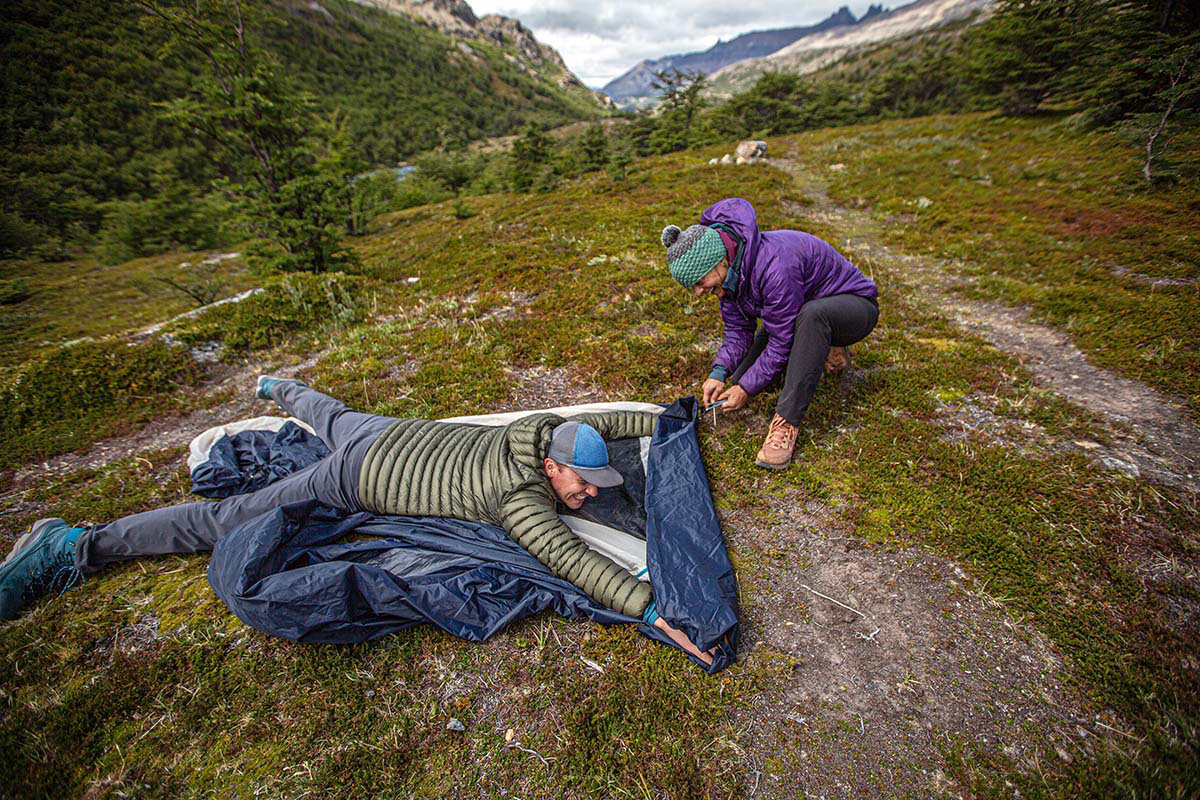
By our own definition, a budget backpacking tent checks in for $350 or less, with some priced as low as around $100. Given that you can spend upwards of $600 on a backpacking tent (or more), there’s no denying that the models here will save you a lot of cash. Of course, it goes without saying that budget tents have their fair share of tradeoffs, especially in terms of weight, packed size, and interior space. But if you’re willing to compromise a little in those areas, the tents here are great and functional low-cost additions to any backpacking kit.
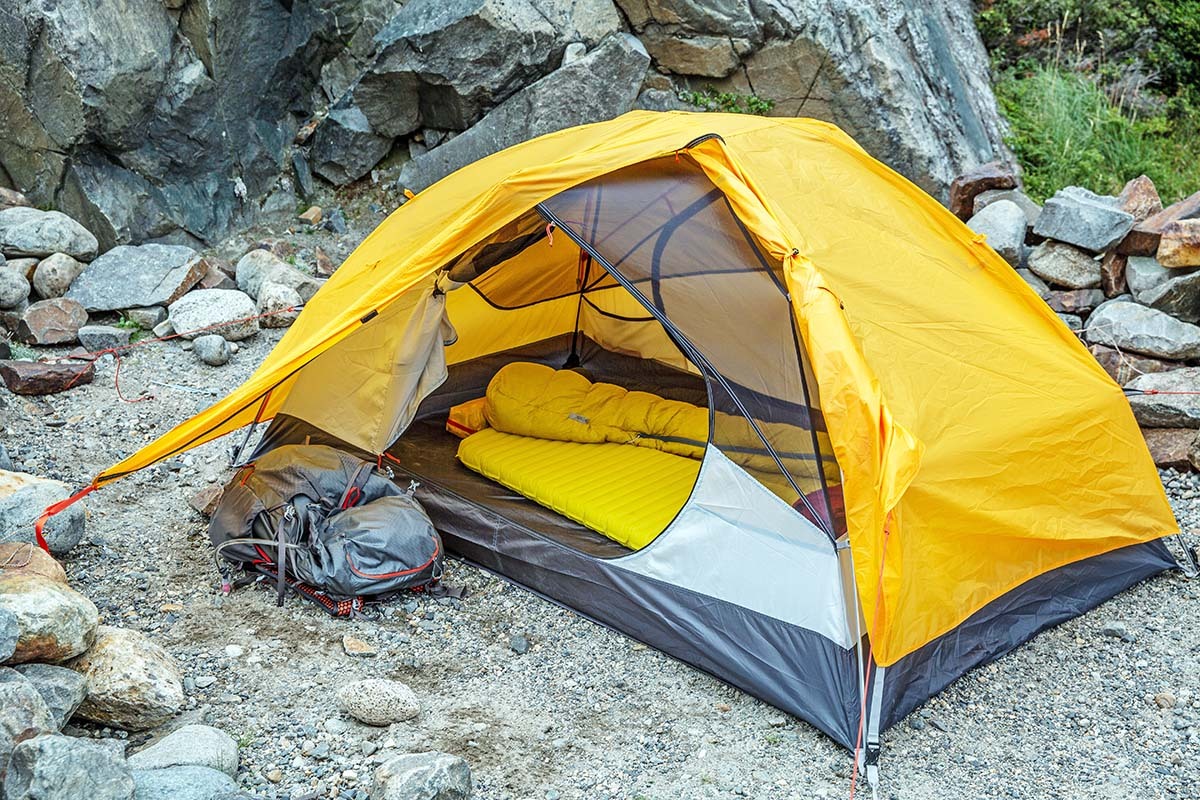
Weight and Packed Size
While premium backpacking tents typically clock in between 2 and 4 pounds for two-person designs, the majority of budget tents hover around 4 to 6 pounds all in (by "all in" we mean the packaged weight, which we explain in more detail below). The reason for this is that manufacturers are able to cut costs considerably by using thicker fabrics, heavier components, and less innovative engineering practices. For casual backpackers who aren’t covering too much ground or only get out a few times a year, the added 1 to 4 pounds shouldn’t be too big of a downside (plus, all of the tents above include a separate tent body and rainfly, meaning you can easily split up the various components with your tent mate). However, if you’re looking to log some serious mileage or want to keep your backpack weight low, it may be worth investing in a lighter and more premium option.
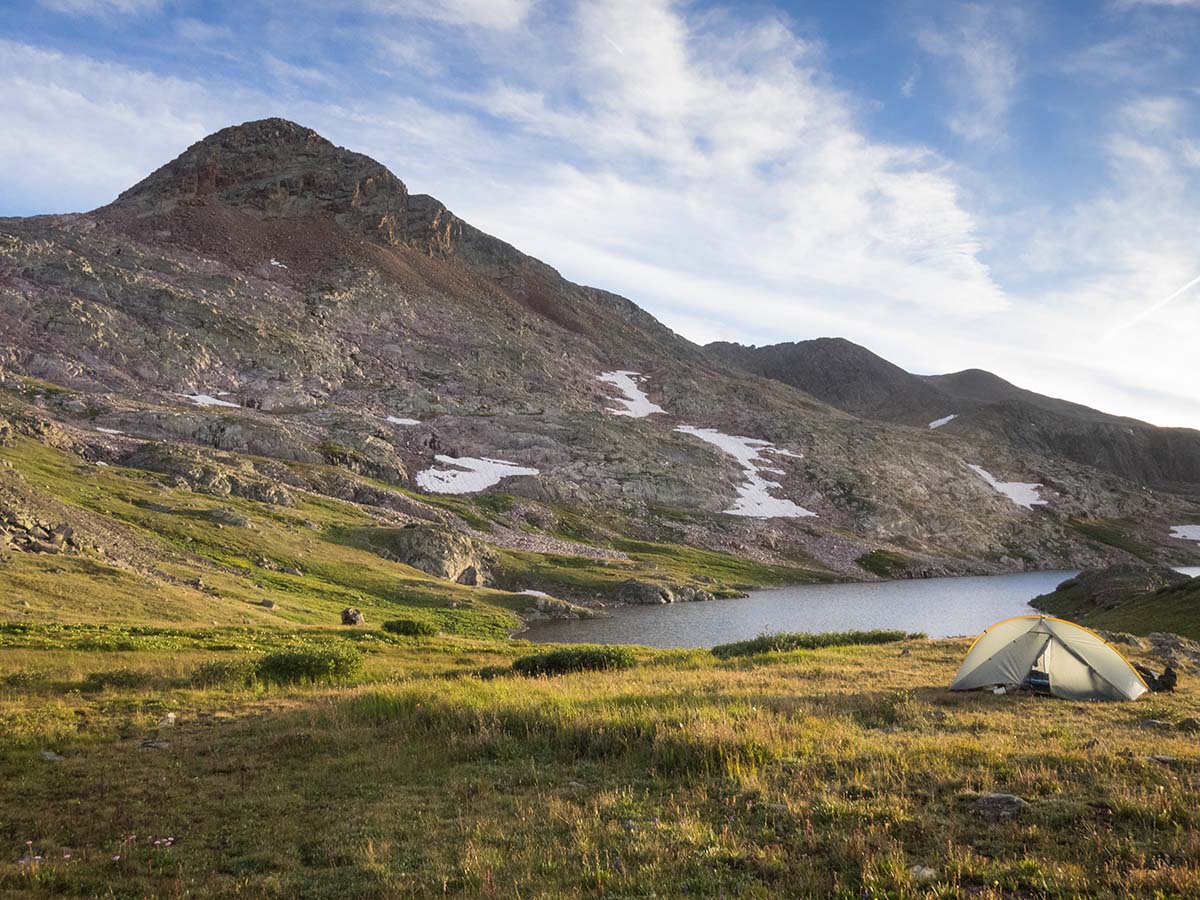
In the majority of cases, packed size also increases with weight, meaning that most budget tents will take up more space in your backpack than premium models. This isn’t great news for those who like to keep a streamlined load, but most entry-level backpackers aren’t carrying sub-50-liter ultralight packs to begin with.
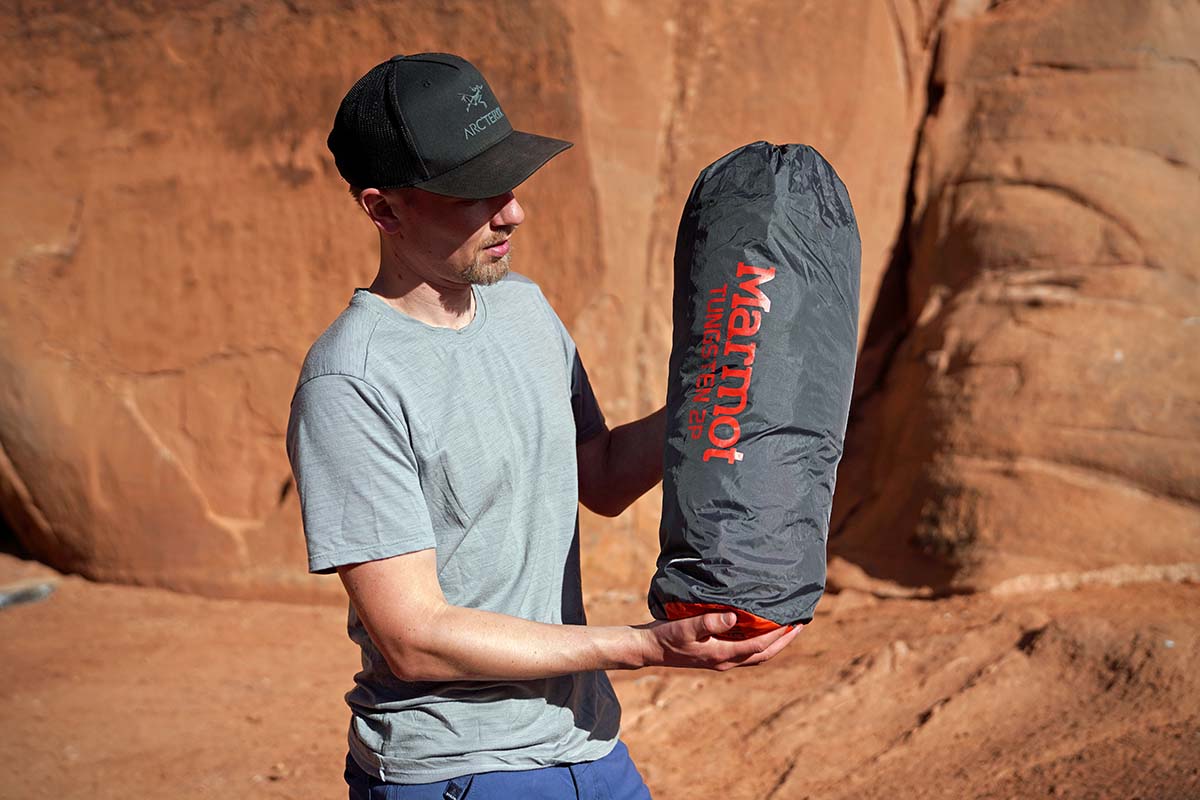
Finally, if you’re not keen to compromise on weight and packed size, there are a few other options for staying within a budget. Solo hikers can opt for a one-person tent, which will generally save you about a pound. For example, the REI Trailmade 2 clocks in at 5 pounds 7 ounces, while the one-person version weighs 5 pounds 1 ounce. Alternatively, it may be worth considering a more affordable ultralight design like the Durston X-Mid 2 ($280) or Tarptent Double Rainbow ($350) mentioned above, which weigh just 2 pounds 7.4 ounces and 2 pounds 9.8 ounces, respectively. Trekking-pole shelters require a little extra care to set up—and they’re generally pricier than true “budget” options—but the weight savings will be well worth it for some. If you're looking to shed weight from your pack, check out our article on the best ultralight tents.

Interior Space
Livability is another place where budget backpacking tents take a real hit compared to the pricier and more premium models. Most two-person tents have similar floor dimensions regardless of their price (and tapered designs exist in both the premium and budget worlds), but the real difference comes in terms of headroom. Tent designers have found a lot of ways to increase a tent’s peak height throughout—including pre-bent poles, ridge poles, and steep walls—creating a lot more space to move around and sit up side-by-side with your tent mate. However, all of these tweaks cost money, so we don’t see them all too often in the budget market.
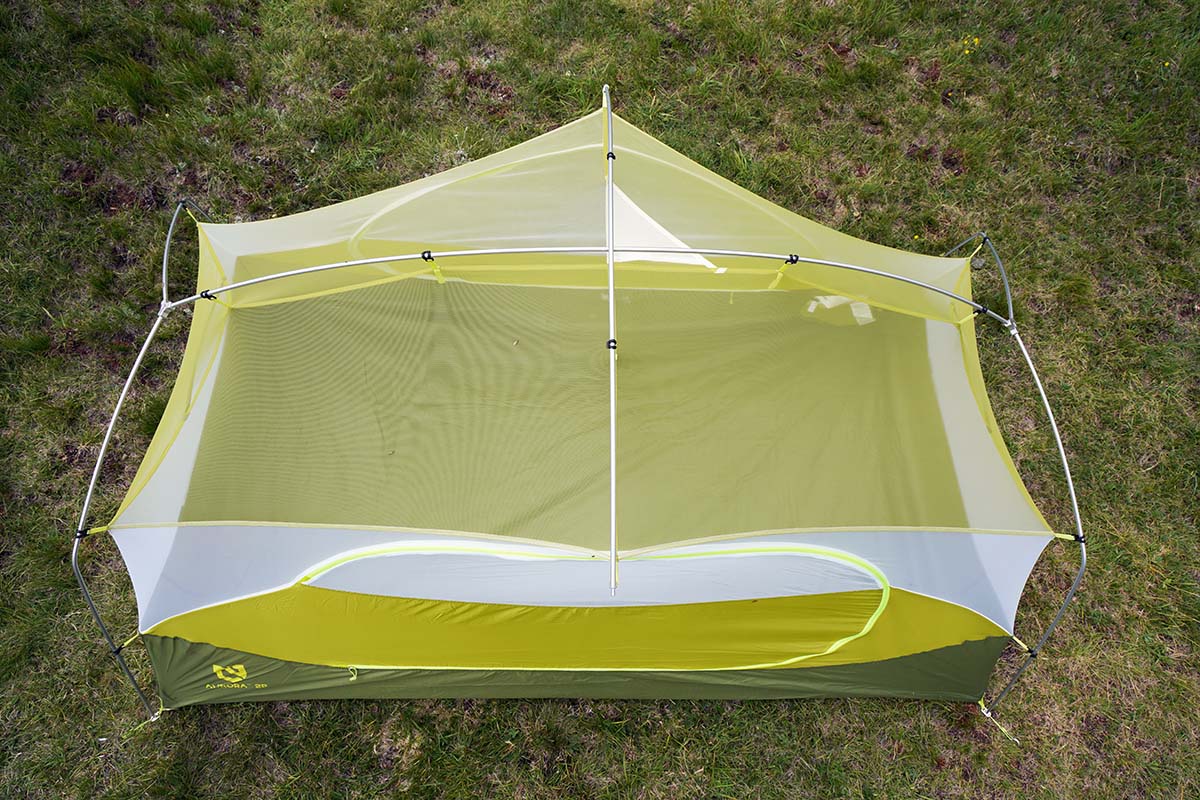
For those looking to maximize livability while staying within a budget, there are a few models to consider, including REI Co-op’s Half Dome 2 and the Nemo Aurora 2P. These tents use the components mentioned above to maximize interior volume and provide considerably more interior space than the more simplistic bargain-basement designs. It’s true that both the Half Dome and Aurora are on the pricier end of the spectrum at $299 and $300 respectively, but the extra investment may be worth it for the boost in comfort—especially for those that anticipate hunkering down in inclement weather or contending with pesky mosquitos.

When researching tent weight, you’ll commonly see manufacturers and retailers list two specs: packaged weight and trail weight (also sometimes referred to as "minimum weight"). The former includes everything that comes with the purchase of the tent, including the tent body, rainfly, poles, stakes, guylines, stuff sacks, and footprint (when applicable). The trail weight, on the other hand, only covers the tent body, rainfly, and poles. We’ve chosen to list packaged weight in the specs above—it’s closer to what most folks realistically bring—but keep in mind that you can trim ounces from there.
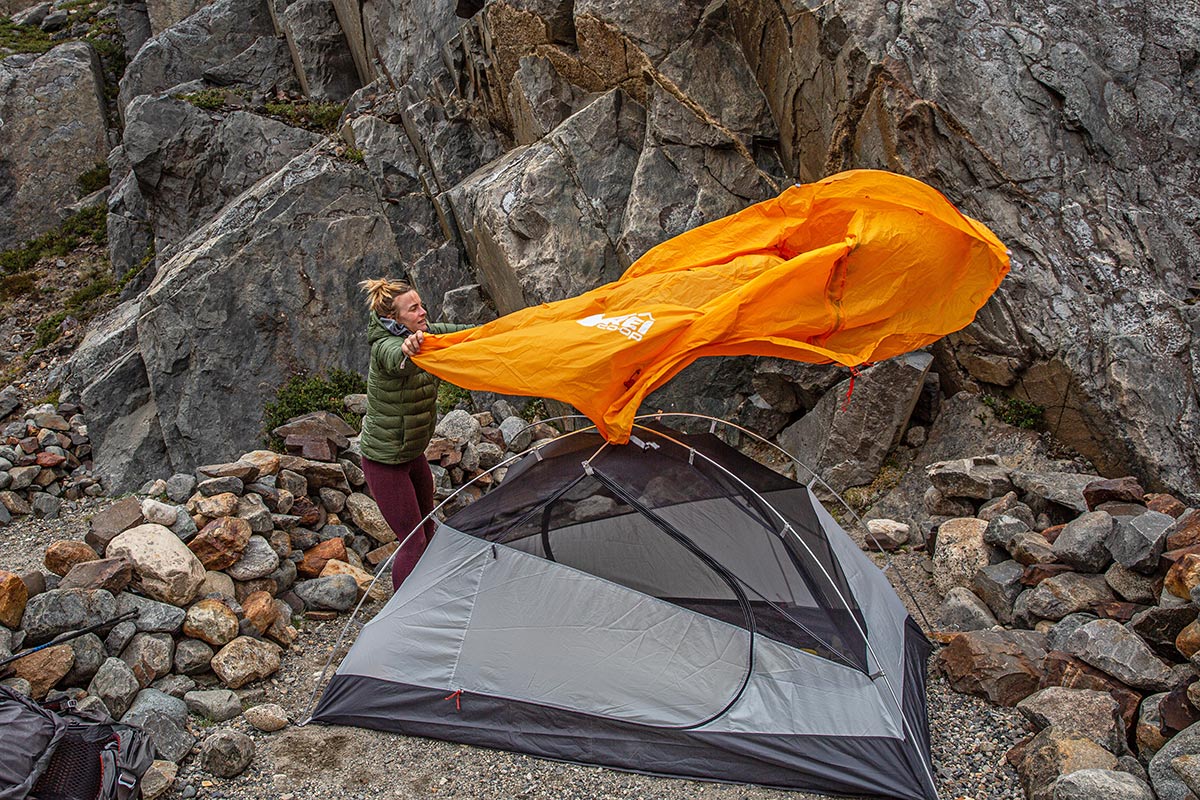
One of the easiest ways to think about tent durability is to consider the thickness of the fabric, which is measured in terms of denier (technically speaking, the weight of the yarn). The higher the denier—of the floor, canopy, and rainfly—the more durable the tent. Logically, denier lines up with weight, which is great news for budget tents (as we mentioned above, a hallmark of budget tents is their heft). For example, the premium Big Agnes Tiger Wall ($480; 2 lb. 8 oz.) has a thin 15D floor, while the 5-pound-7-ounce REI Trailmade 2 ($199) uses a robust 66D fabric. Because the area most vulnerable to punctures or tears is the floor, this is the number we list in the specs and comparison table above.
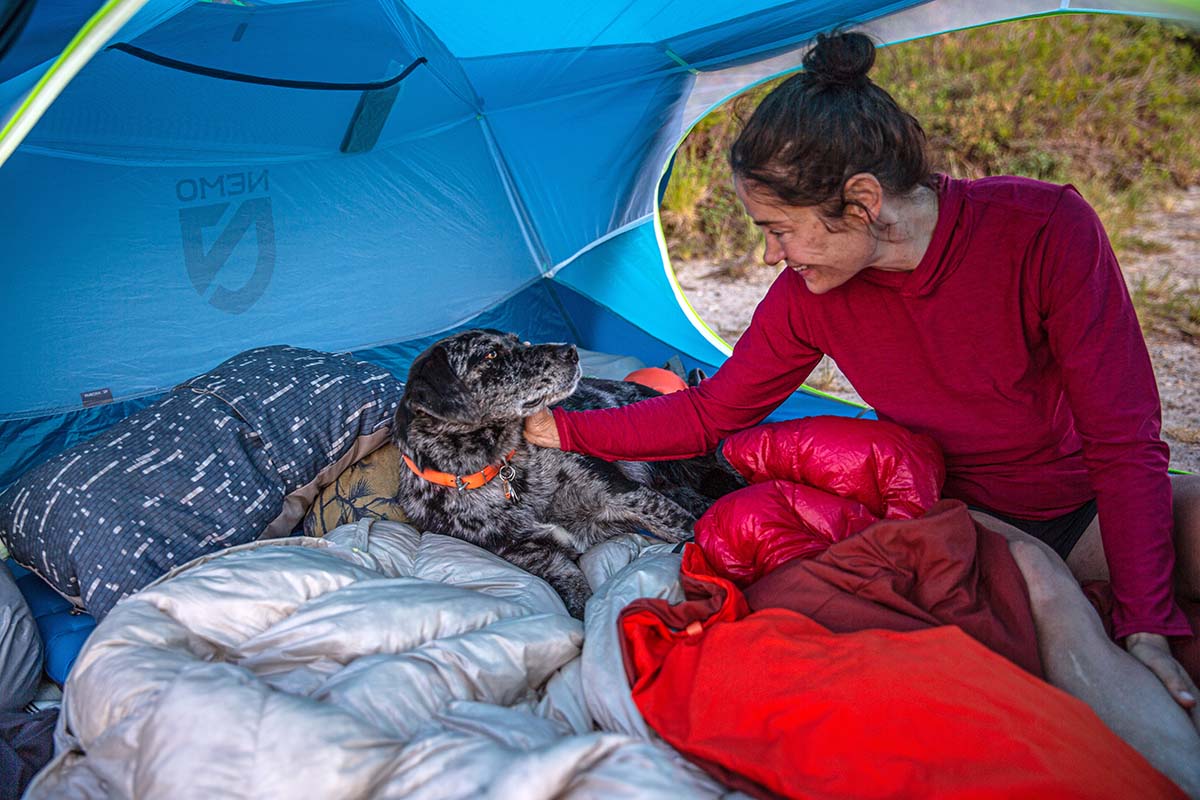
While fabric thickness is a large factor in determining a tent’s durability, it’s not the only one. The quality of the rest of the materials (poles, zippers, etc.) also plays a part, as does the attention to detail. And while premium tents will often add a silicone coating (also referred to as “silnylon”) to their thin fabrics for additional tear strength and longevity, we don’t see this technology on budget designs. We’ve learned to trust the build quality of budget tents from leading manufacturers like REI, Nemo, and Big Agnes, but you’ll want to be a bit more careful with dedicated budget brands like Alps Mountaineering which specialize in the entry-level market. All that said, in most cases, increased durability is a significant and surprising benefit of opting for a budget model.
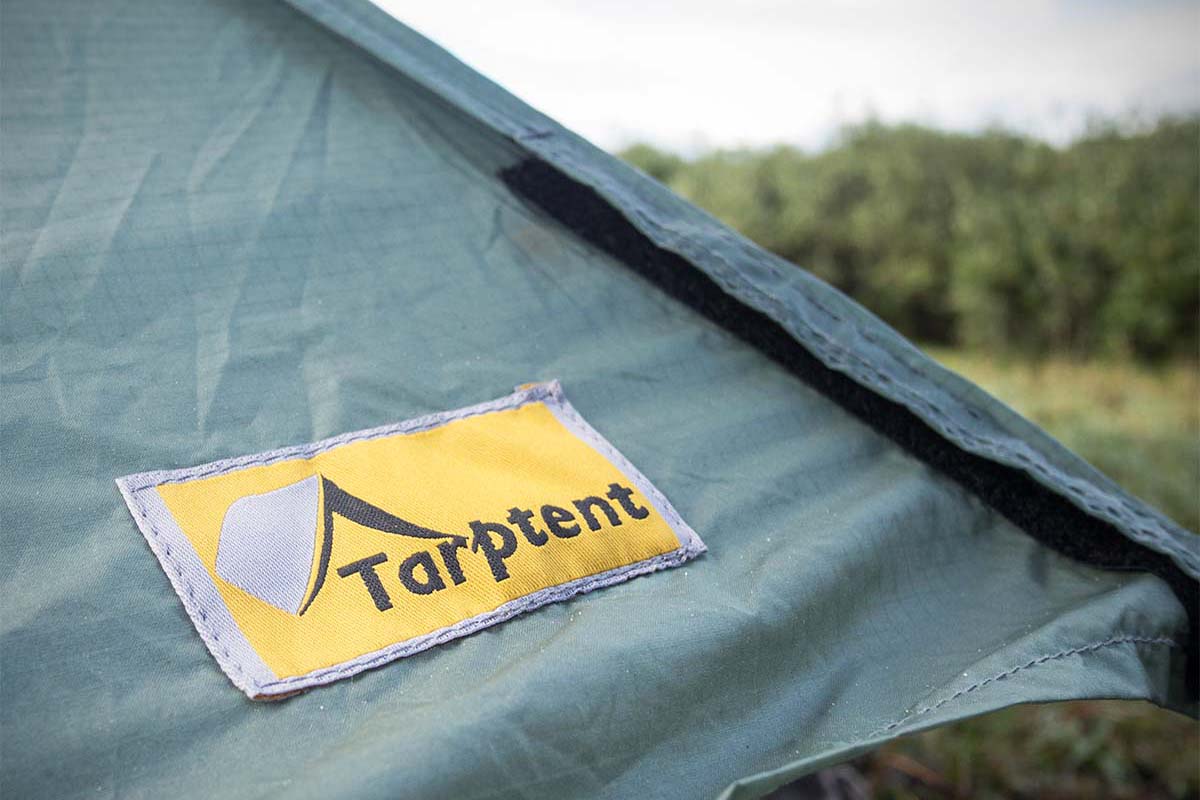
Protection from the elements is one of the primary functions of a backpacking tent. In general, budget tents do a respectable job keeping out wind and rain and perform on par with much of the more premium competition. Your first line of defense is a rainfly, and you’ll want to look for coverage extending below the bathtub floor of the tent body to maximize weather protection (manufacturers sometimes shorten the length of parts of the fly to save weight). A generous bathtub floor is also important for guarding against splashes and puddles. Finally, it’s important to evaluate the tent’s overall structure, including strong poles and lots of exterior ties to anchor it down in heavy winds.

If you’re like most backpackers and get up into the mountains just a few weekends a year during the summer months, you shouldn’t have any issue with the tents above. A full-mesh tent like the Kelty Late Start will offer the least amount of protection, while a design with more solid materials in the canopy (like the Trail Hut or Lynx) will be a better match for bad weather. However, you’ll want to be careful not to push any of these tents too hard in extreme conditions. If heavy winds or snow are in the forecast, a true 4-season tent will be much more capable and confidence-inspiring. We don’t see a lot of budget designs in the 4-season category—these tents are highly engineered for tackling bad weather—but there are some more affordable options to consider, including the Alps Mountaineering Tasmanian 2 ($250).

Like weather protection, ventilation doesn’t take too big of a hit in the budget market. Ventilation depends on two main factors: the amount of mesh on the tent body and the quality and quantity of vents in the fly. Most budget tents have generous mesh panels, which are great for keeping air circulating—in good weather, you can even leave the rainfly off for unmitigated airflow. With the rainfly on, things get a bit trickier: Given the waterproof fabrics and sealed seams, breathability is inherently compromised. For this reason, fly vents are vital, and in general are fairly well-executed in the designs above (although they're notable omissions on the Kelty Late Start). For more on tent ventilation, see the buying advice section in our article on the best backpacking tents.
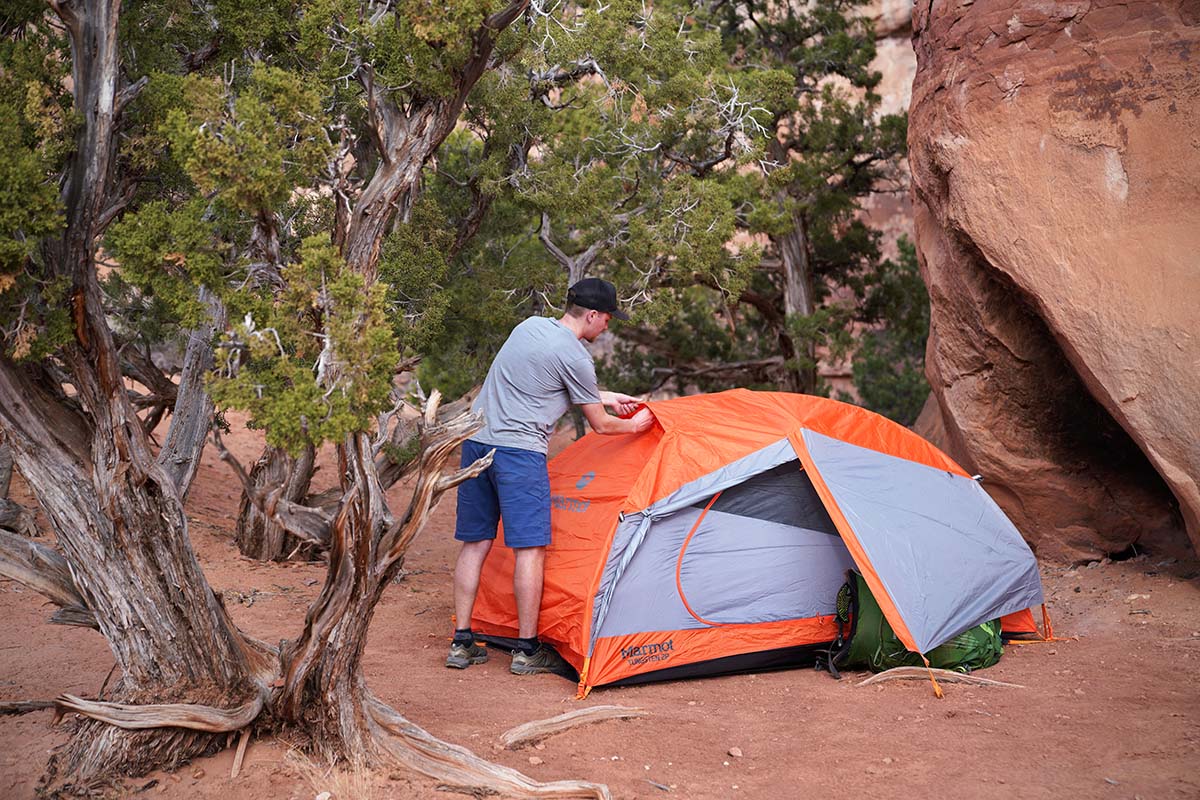
Like the higher-end competition, budget backpacking tents feature a range of storage options, including vestibules and both interior pockets and gear loops. Vestibules are indispensable for organizing your gear at camp: They cover the tent’s door while leaving enough space for items you don’t want in your sleeping area, including your backpacking pack and hiking shoes. In general, budget designs stack up very well to their pricier counterparts in vestibule space: For example, the REI Co-op Trailmade 2 ($199) boasts 19 square feet split between the two sides, while a premium option like the Big Agnes Copper Spur UL2 ($550) has a comparable 18 square feet of space. However, be on the lookout for tents that feature just one vestibule (and door), including the Kelty Late Start and Big Agnes C Bar, as these are far less convenient for two campers to stash gear and move around in comfortably (more on this below).

When it comes to interior storage, the budget market often has a bit less to offer. It’s standard to see fairly streamlined feature sets, including just a few pockets and gear loops. On the other hand, pricier tents might have a larger variety of stash pockets, light-diffusing pockets or built-in light strips, thoughtfully placed gear loops, and more. In general, higher-end budget designs are a great middle ground between those two extremes, including the Nemo Aurora and REI Half Dome. If you spend a lot of time basecamping or delight in keeping the interior of your tent organized, you'll want to opt for one of these more featured options.
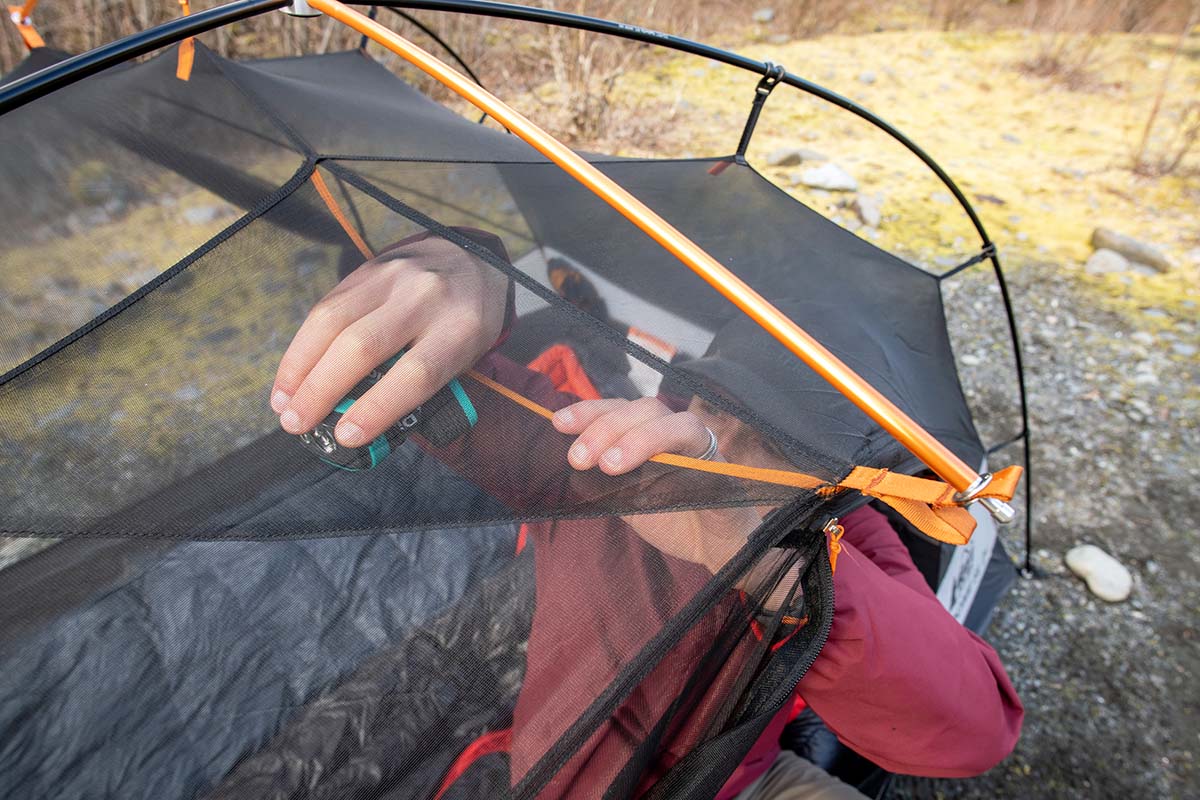
The majority of tents above feature two doors, which is by far our favorite configuration. If you plan to consistently camp with a partner, it’ll likely be your preferred setup too. For reference, a few models above use just one door to save weight—the Big Agnes C Bar 2 has one on its end, while the Kelty Late Start puts its entry on the side. If you’re sharing the tent with a partner, this can be a major downside—you’ll be crawling over your tent mate to get in and out and will be limited to one vestibule for exterior storage. In the end, unless you’re traveling alone or pulling out all the stops to save weight, we recommend a tent with two doors.
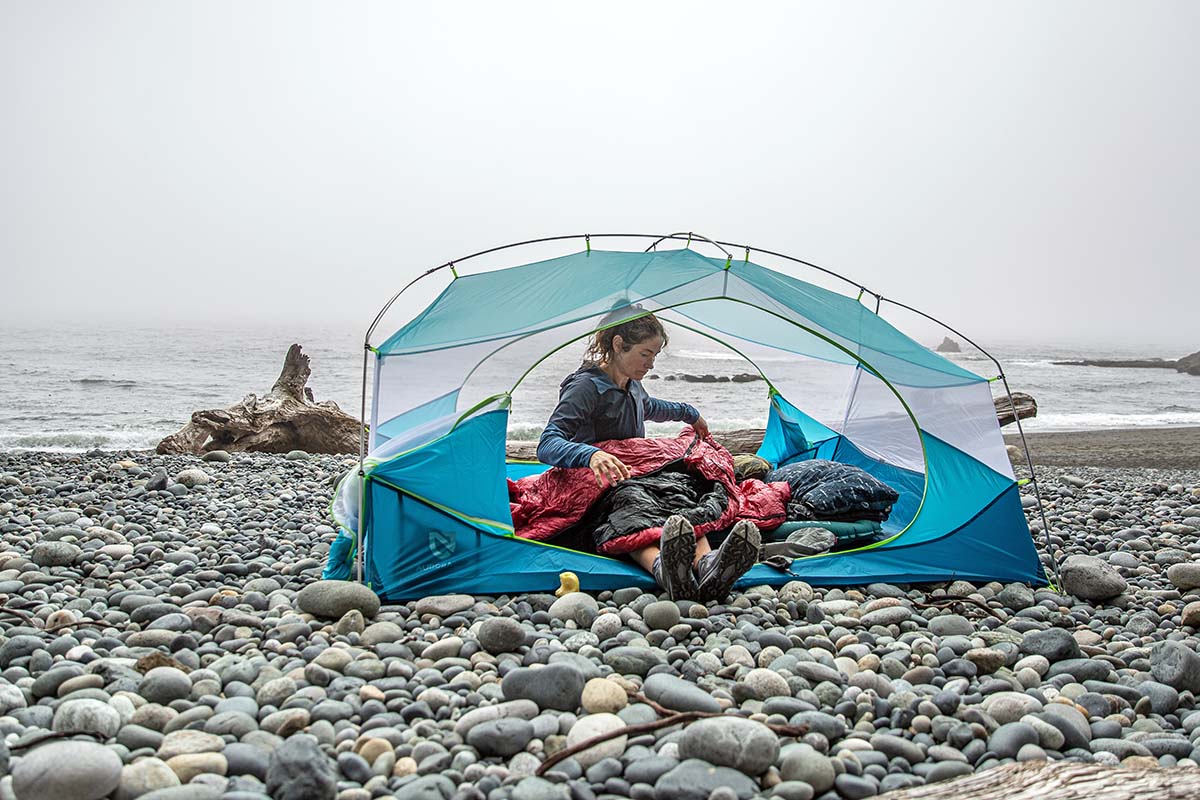
Most of the backpacking tents above are of the two-person variety, with floor plans that can accommodate two 20-inch sleeping pads side-by-side. The two-person tent is the most popular capacity, but many backpacking models also come in one, three, and four-person designs. Solo travelers can save some weight by opting for a one-person option (like the Alps Mountaineering Lynx 1), while families or couples traveling with a dog can bump up to a three- or four-person model. It almost goes without saying that weight and packed size will increase alongside capacity, but it is worth noting that, in general, one four-person tent will be lighter than two two-person models. For example, the Marmot Tungsten 4 checks in at 7 pounds 15 ounces, while the two-person version weighs 4 pounds 15.7 ounces (note: Both are "minimum" rather than packaged weight, as Marmot does not provide the latter spec).
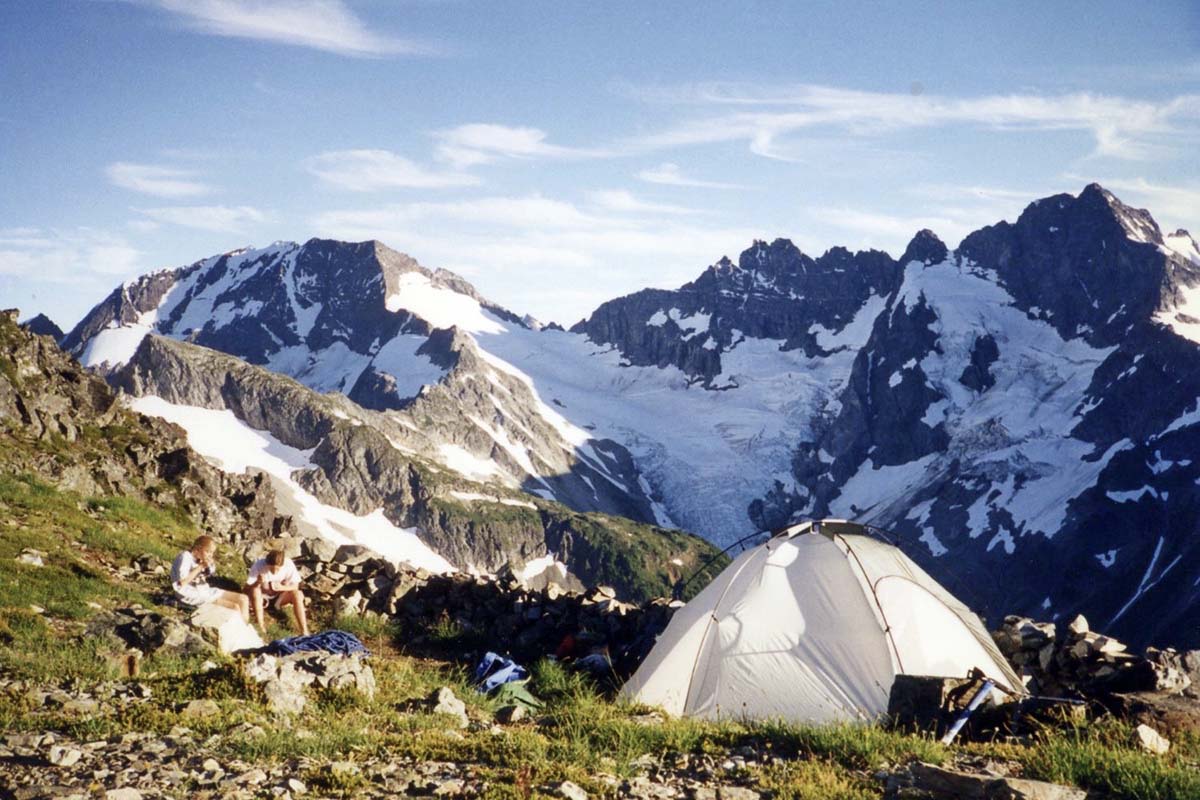
Setting up a modern tent has become surprisingly easy, with simple clips and grommets that take a matter of seconds to attach and streamlined poles that come together with ease. Some budget tents even feature sleek additions more commonly seen in the premium market, including color-coded components, hubbed pole structures, and clip attachments to secure the rainfly. On the flip side, some of the more basic models forgo most of these features, and tents like the Kelty Late Start have kept things pretty old-school with sleeves to run the poles through. Gripes aside, all of the tents above are fairly quick and intuitive to pitch, even for the greenest of backpackers. The whole process usually takes just a few minutes from start to finish, which is fantastic.
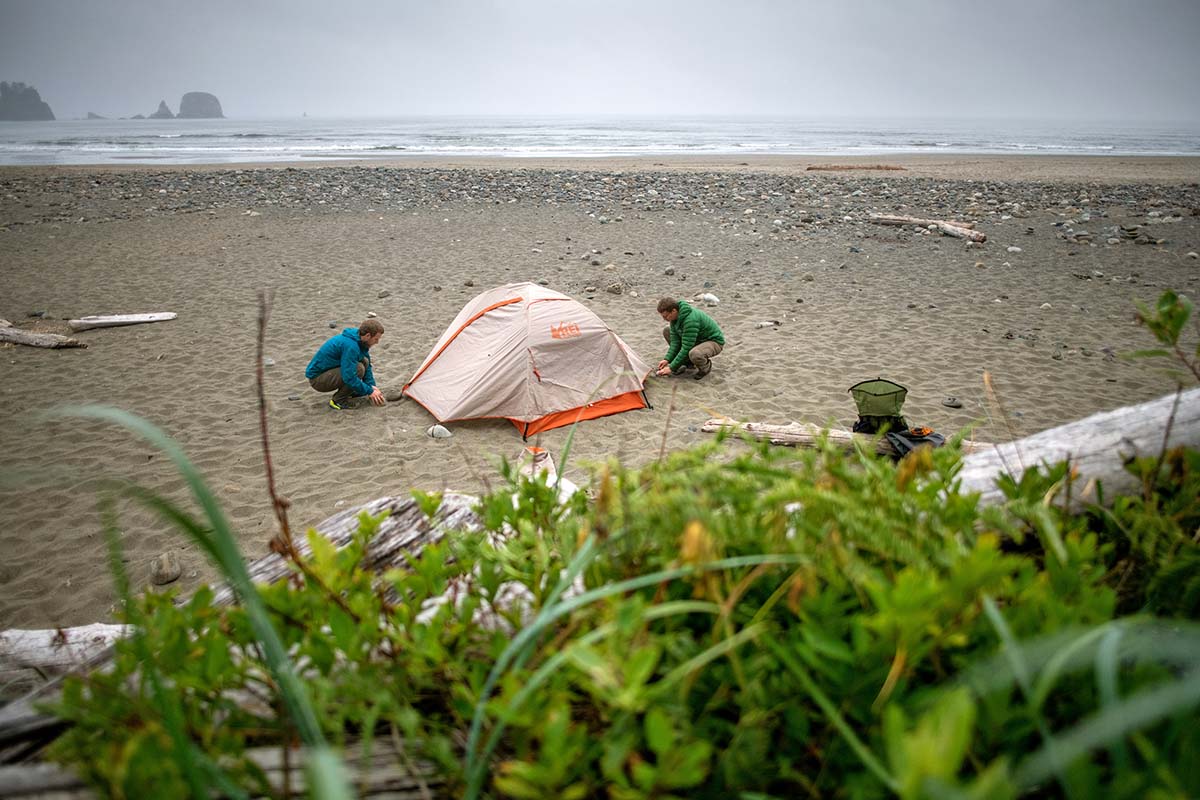
Without getting too into the nitty gritty on tent poles and stakes, there are a few things we want to mention with respect to budget tents. In terms of poles, most are made with simple aluminum, which is decently durable but heavier than the premium aluminum and carbon fiber found in pricier designs. We also see a lot of simple pole layouts in the budget world: For example, the REI Co-op Trailmade 2 features two poles of identical length that crisscross at the apex of the tent and are held secure by a large clip attached to the tent body. Getting into the more premium side of the budget market (including models like the MSR Elixir 2 and Nemo Aurora 2P), we start to see more complex pole structures, including the addition of a ridge pole at the apex and hubbed poles, which offer more rigidity and easier setup.
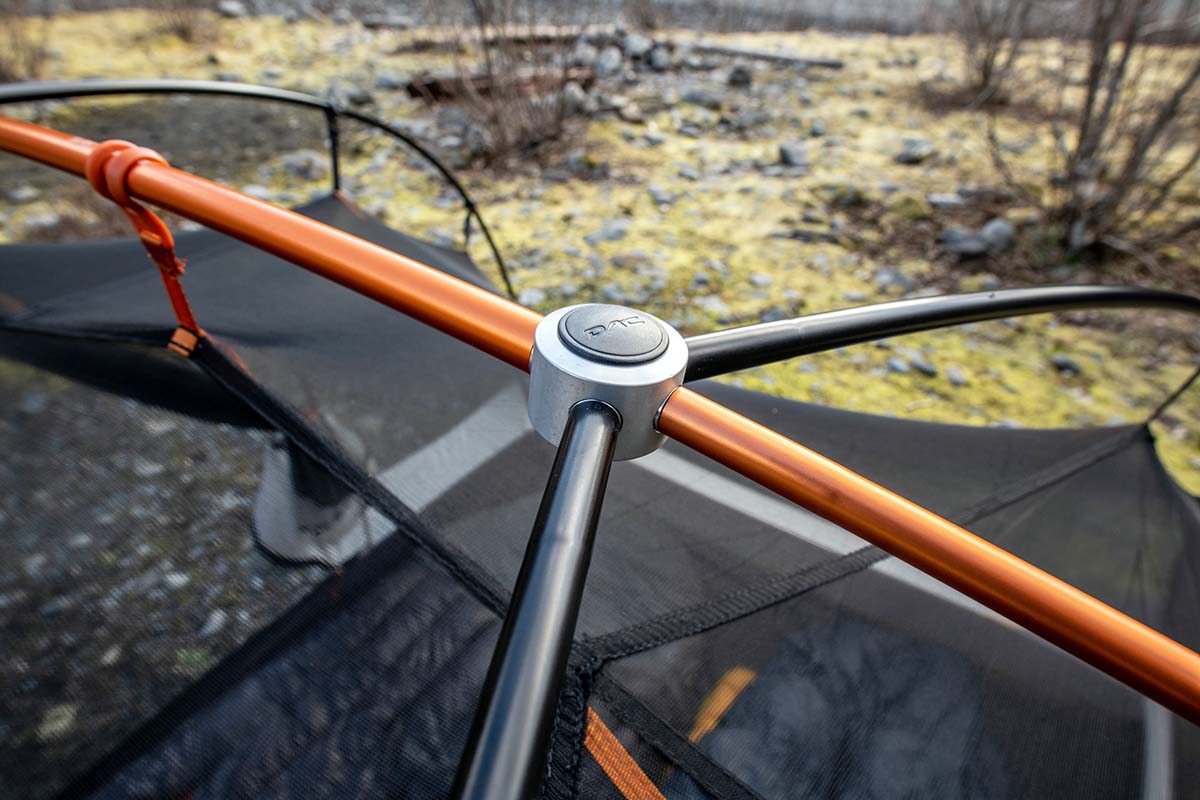
Most two-person budget tents will come with about six stakes: one for each corner and one for each side of the vestibule. In general, these stakes are of the hook-style aluminum variety, which are heavy and can be a pain to use: They're often too thick and round to sink easily into the ground and have a tendency to bend when being hammered in. To be sure, they'll do the trick for most, but upgrading isn’t very expensive. We especially like the MSR Groundhog Stakes: They are light, tough, and easy to pound reliably into the ground.
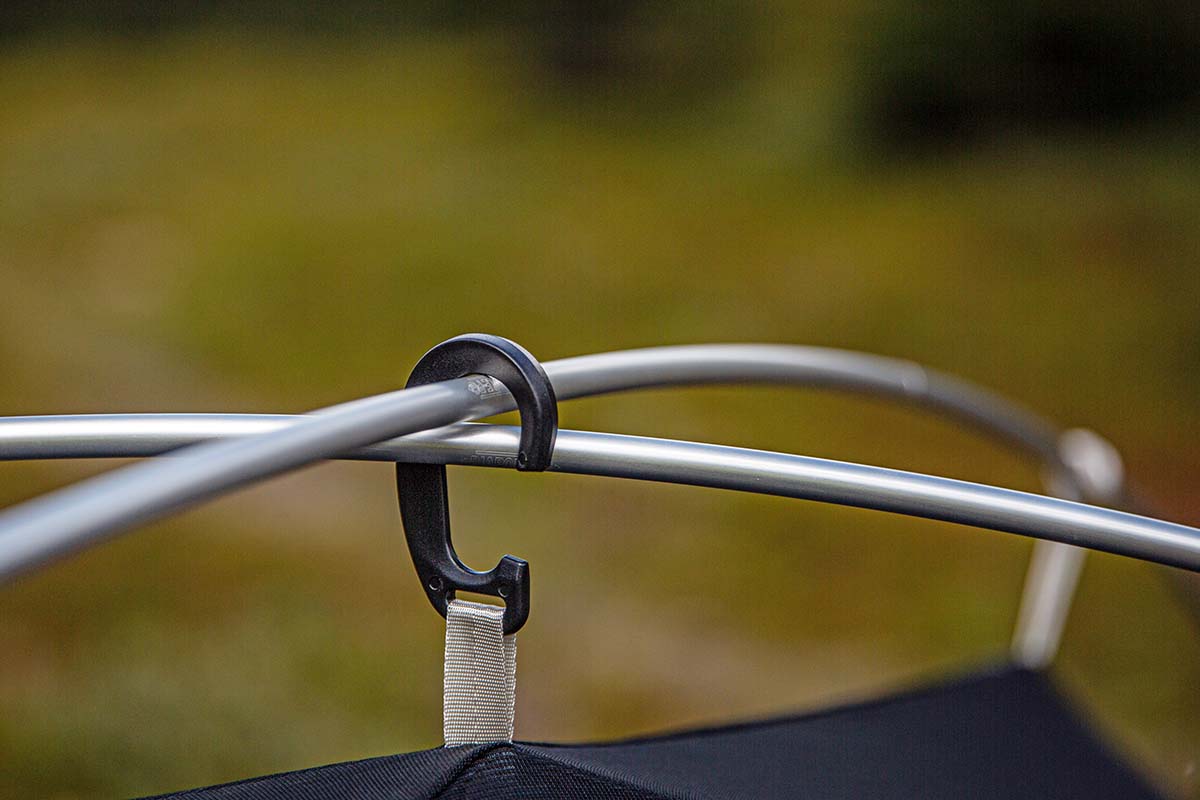
We’ll start by noting that a footprint is optional—some of the tents above come with an included footprint, while others do not. These simple tarps go beneath your tent (usually attaching to the pole in each corner) to provide an extra layer of protection underneath. They’re a nice added bit of assurance to have when it’s wet (make sure to tuck them under the tent to avoid pooling, as that can have the opposite effect) or when you’re camped on rough surfaces like granite or sharp plants. That said, they do add an additional cost (a $40 footprint would increase the price of a $200 tent by a whopping 20%) and 5 to 10 ounces of weight to your pack.
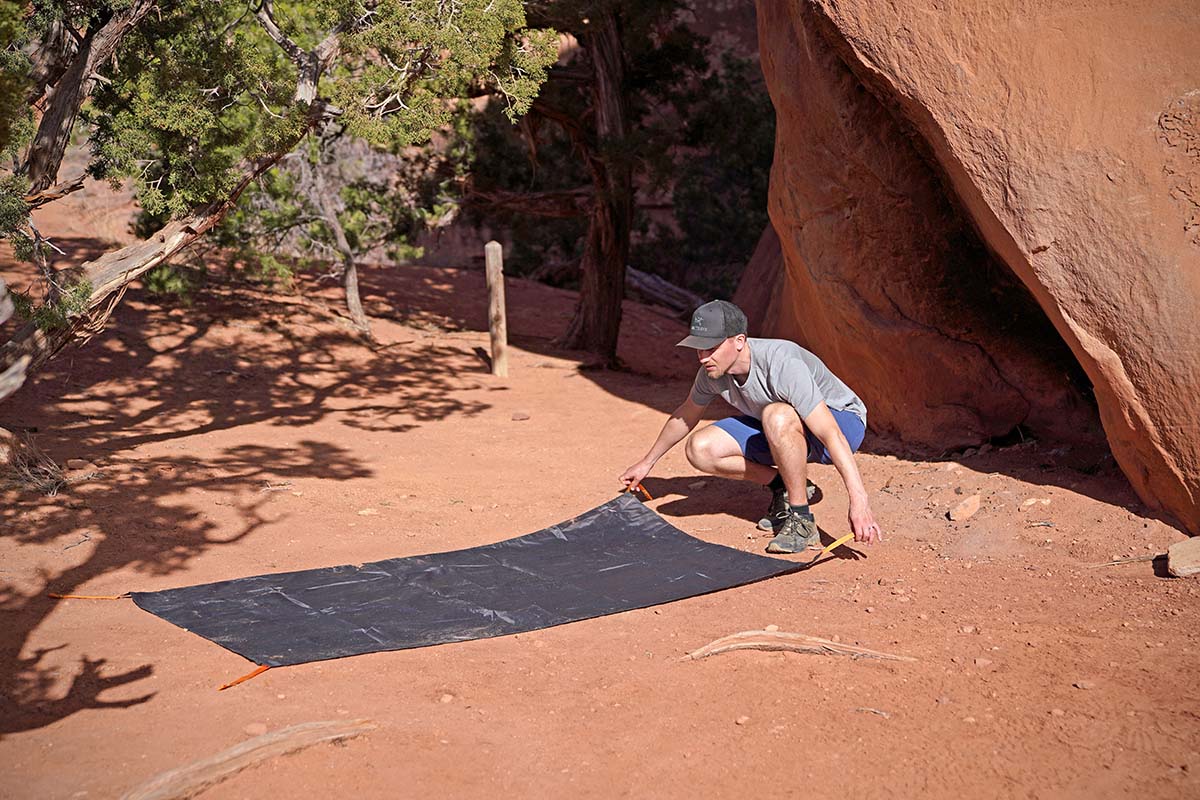
Here’s our take: For the majority of budget tents, a footprint is not really necessary. As we covered above, the tents listed here have fairly robust floors, ranging from 30D to 75D. Compared to more premium tents (which usually clock in between 15 and 30D), they’re pretty darn durable on their own. If you plan on camping on rough surfaces, tend to be careless with your gear, or you don’t have the risk tolerance for a torn floor (and the subsequent repair), it might be worth taking a footprint along. But in most cases, it’s highly unlikely that your tent's floor will rip. For more information on this topic, see our article: Does Your Backpacking Tent Need a Footprint?
Back to Our Top Budget Tent Picks Back to Our Budget Tent Comparison Table